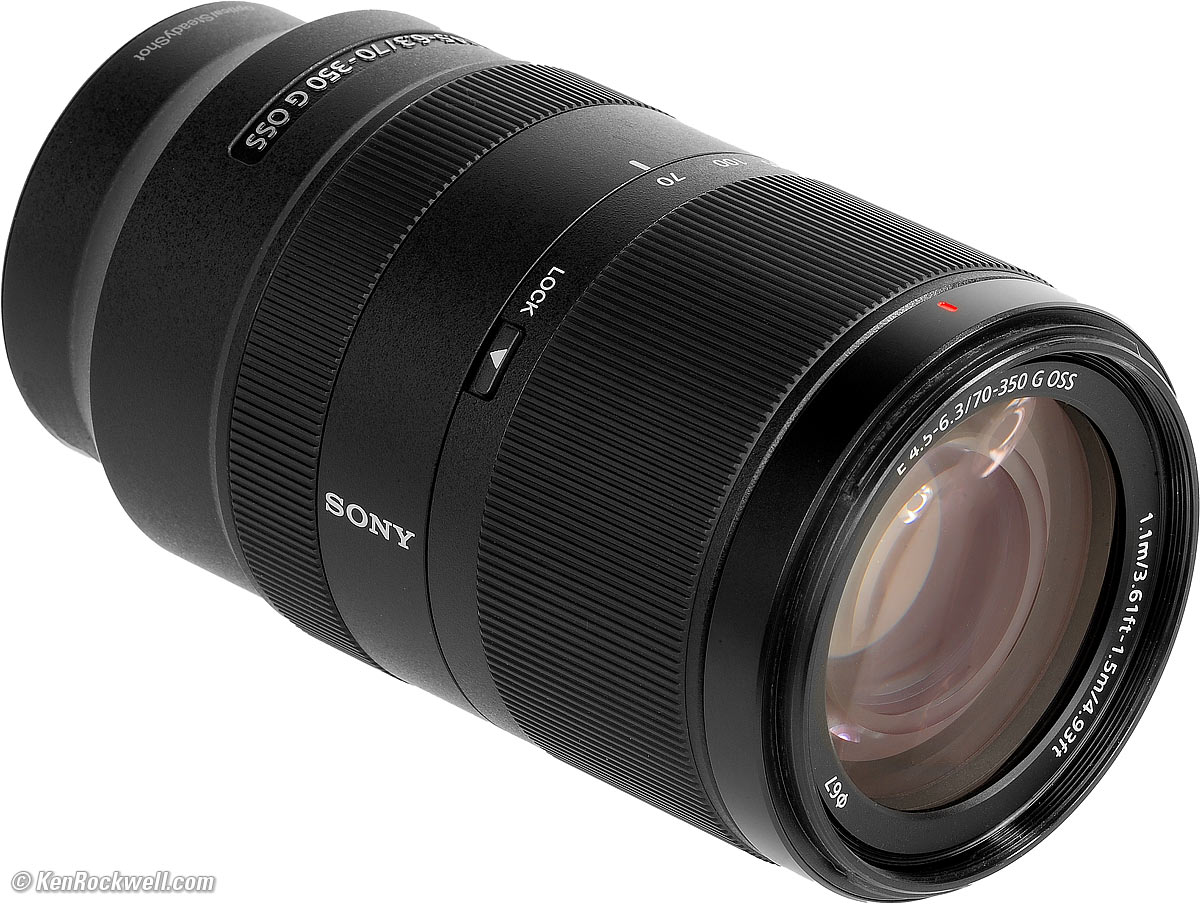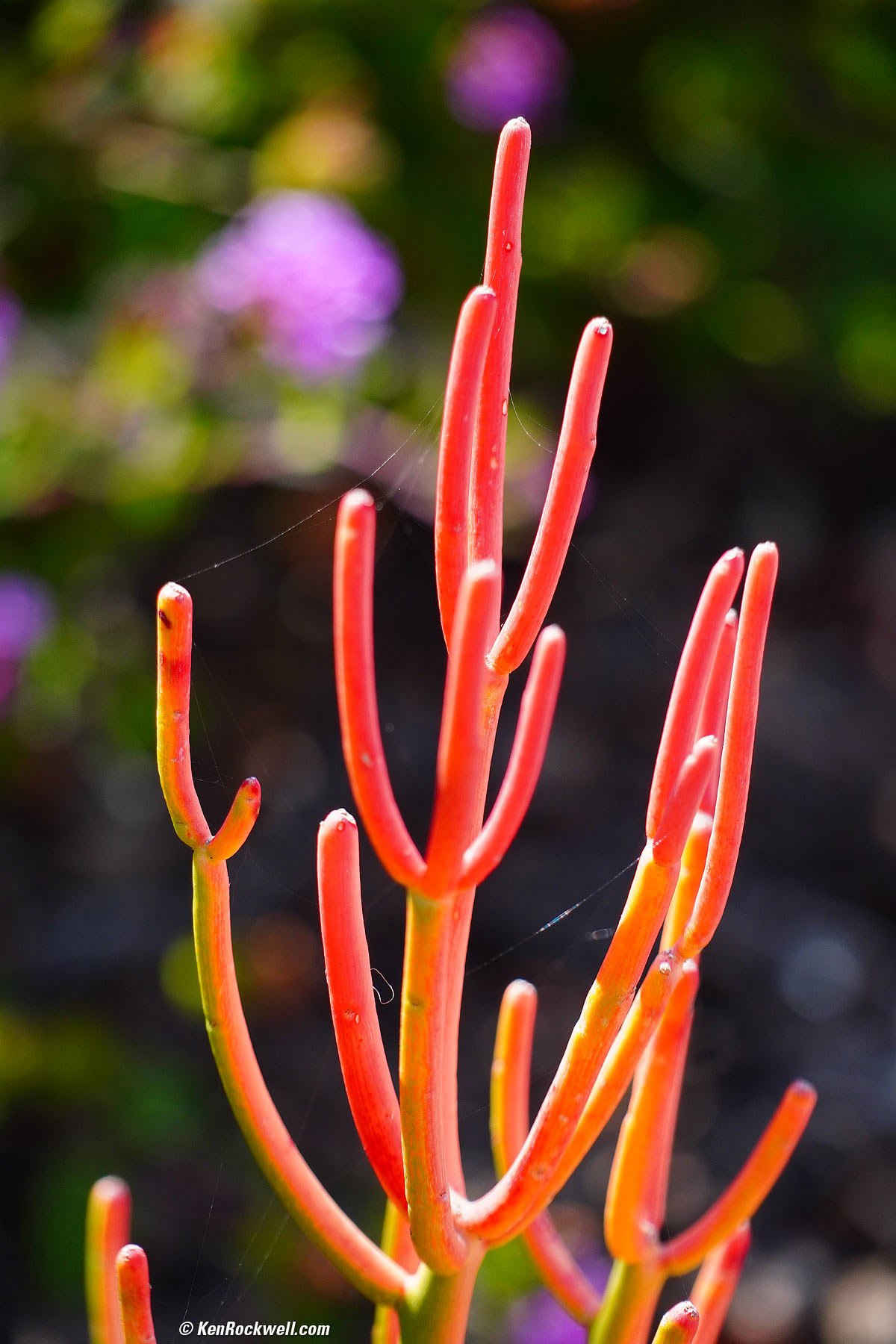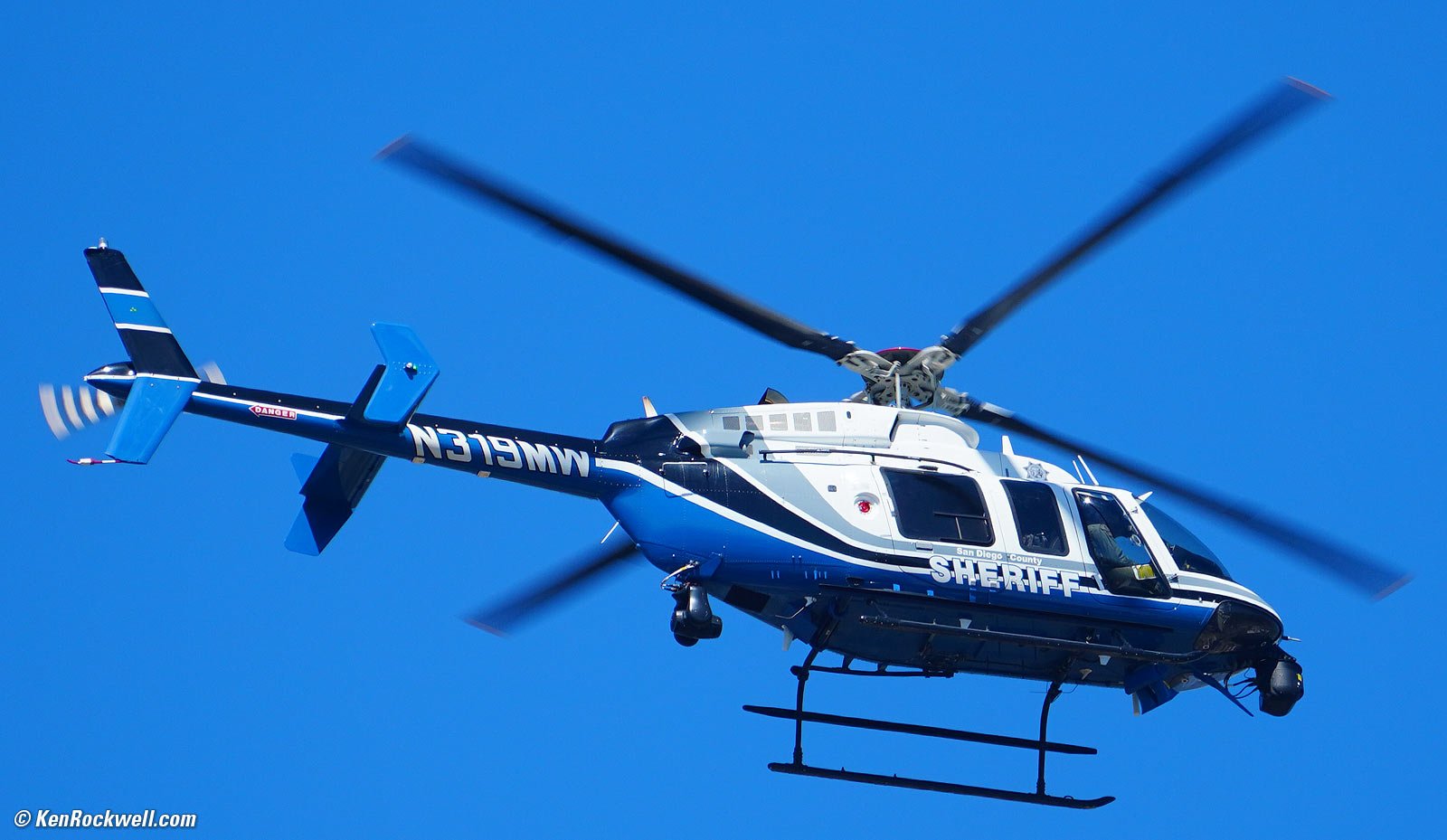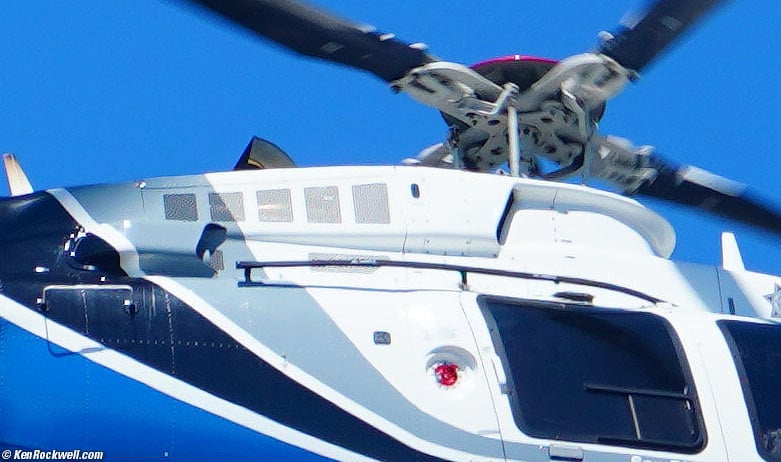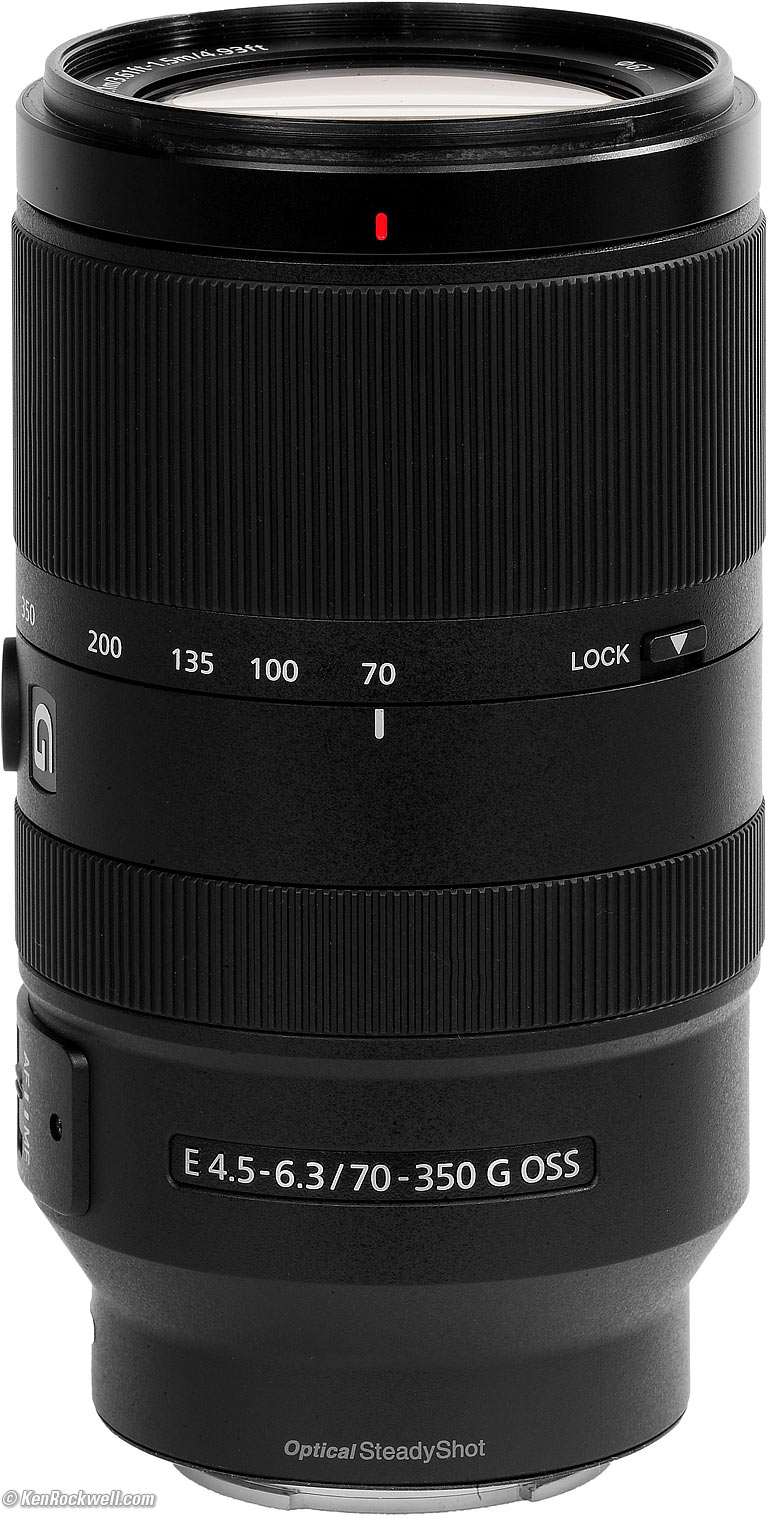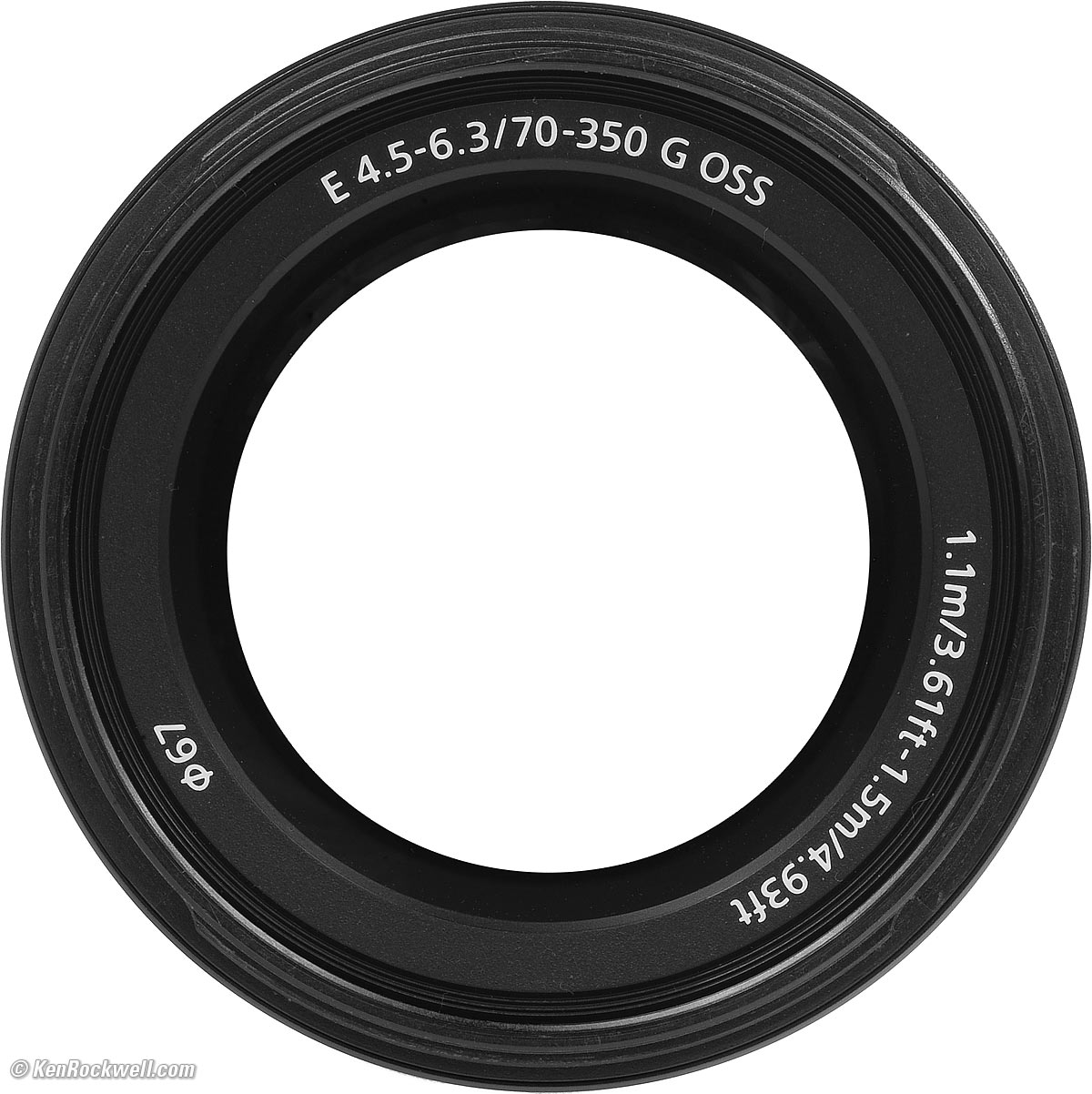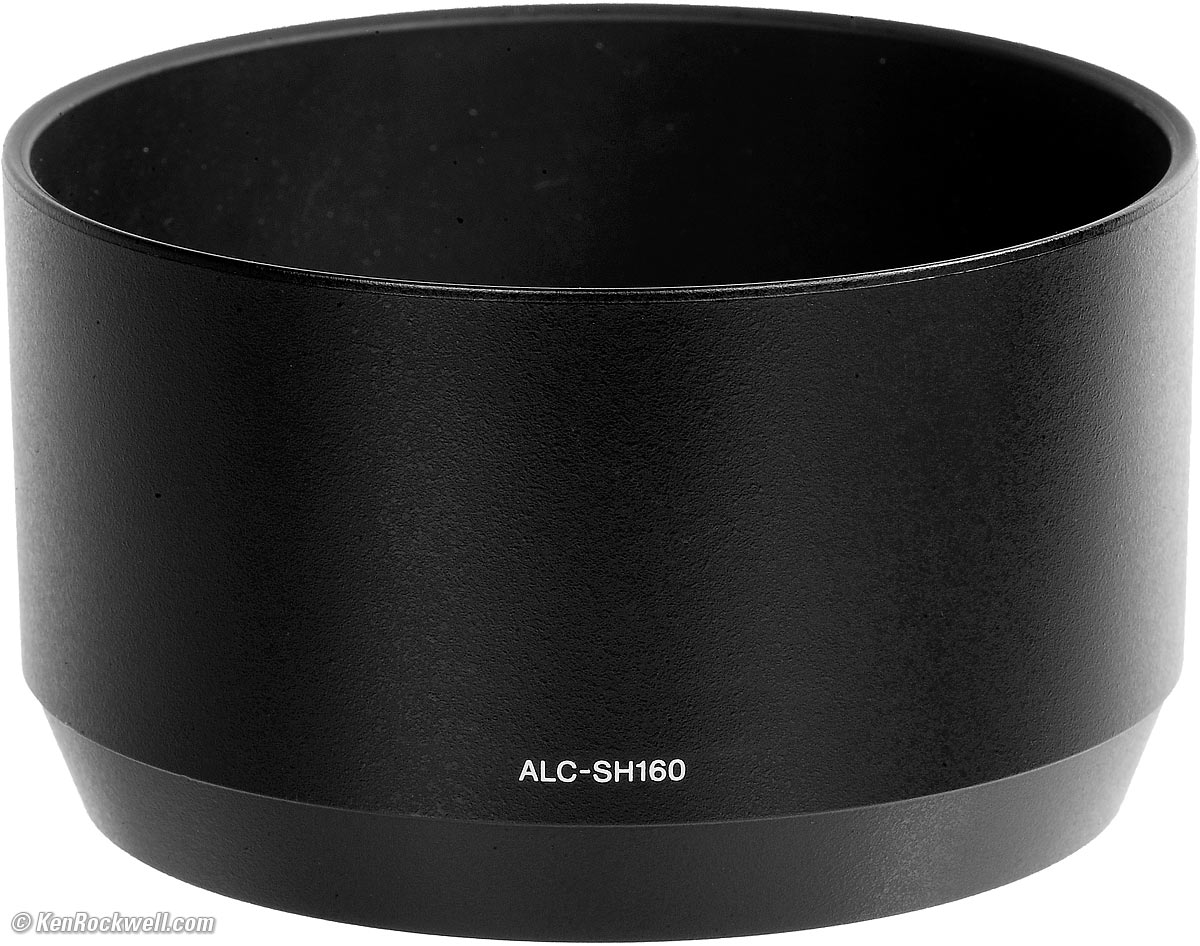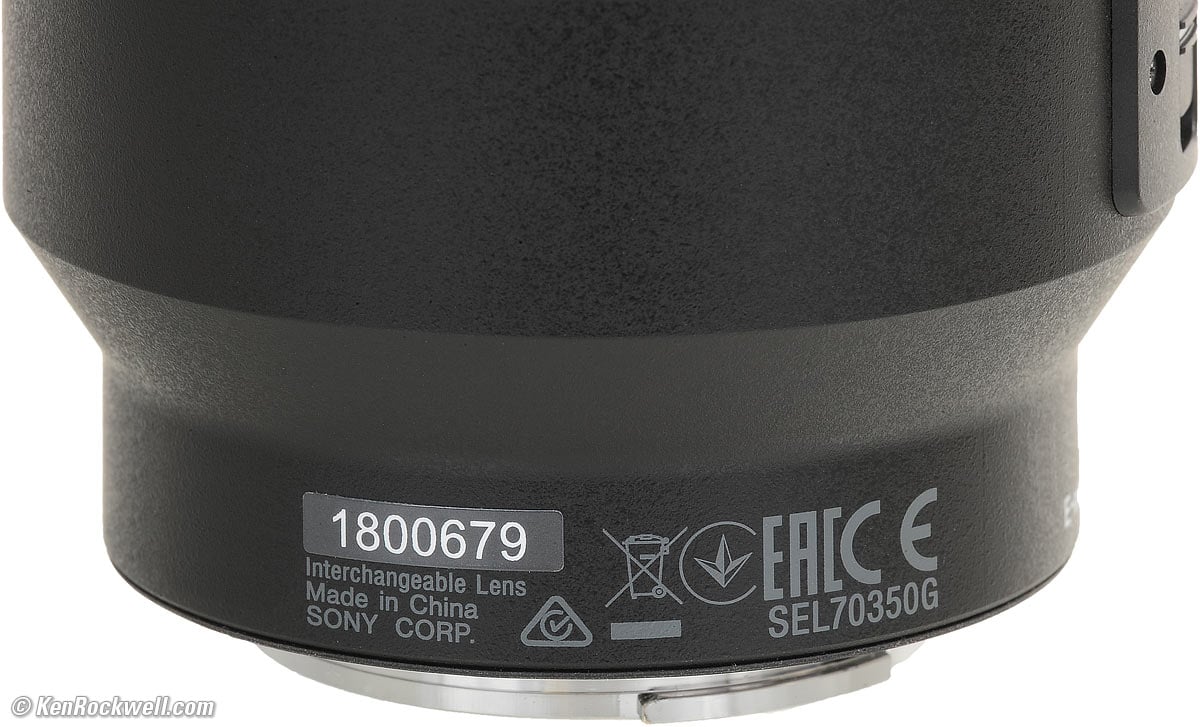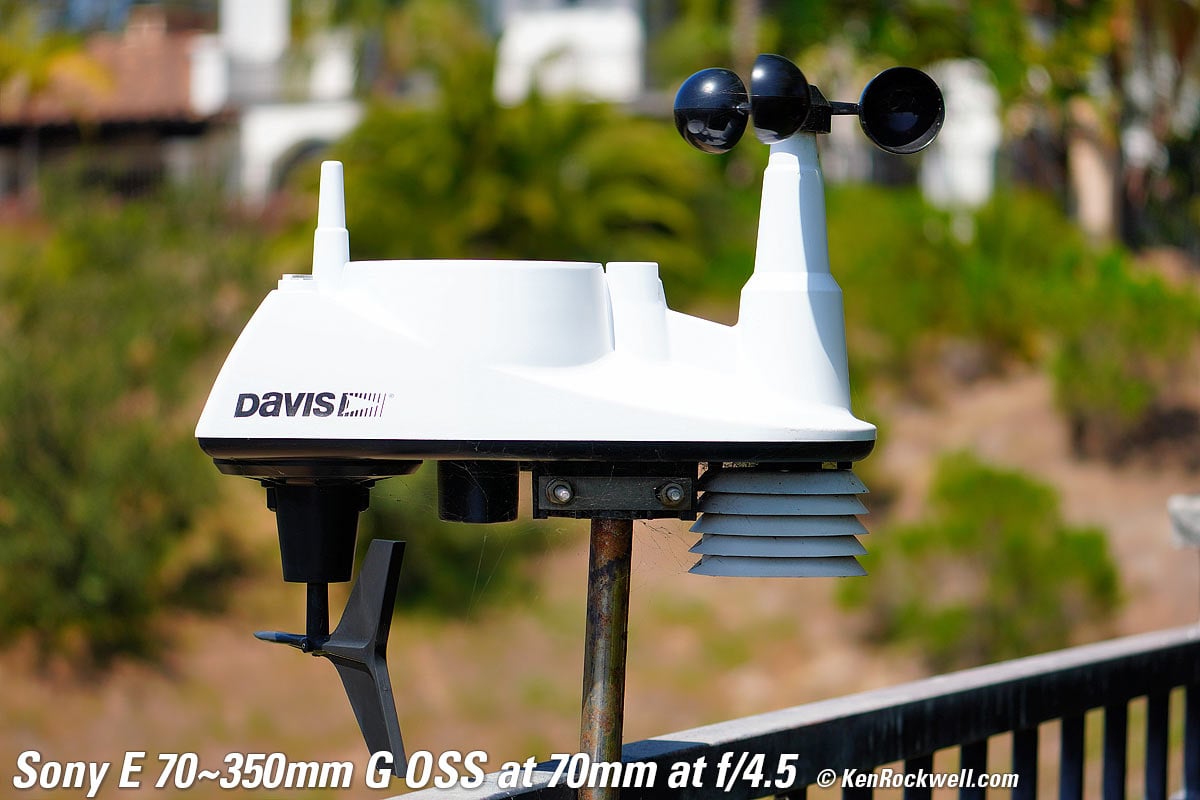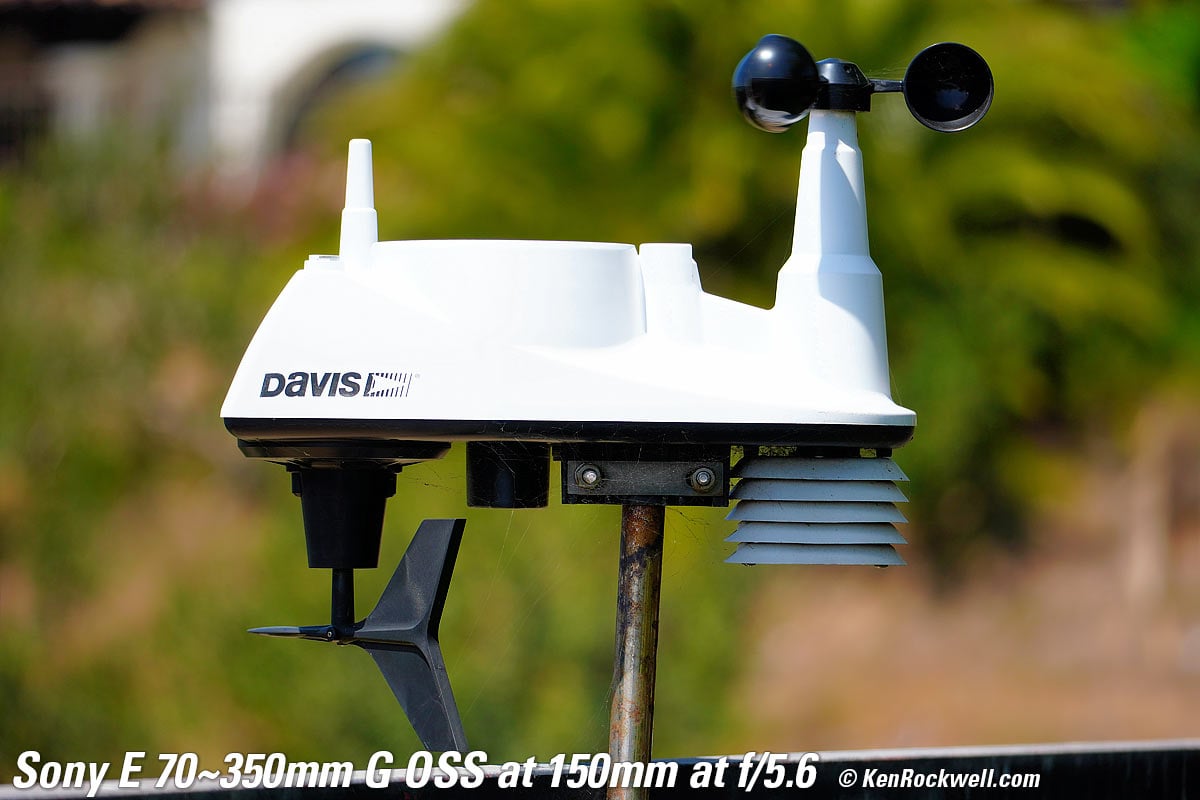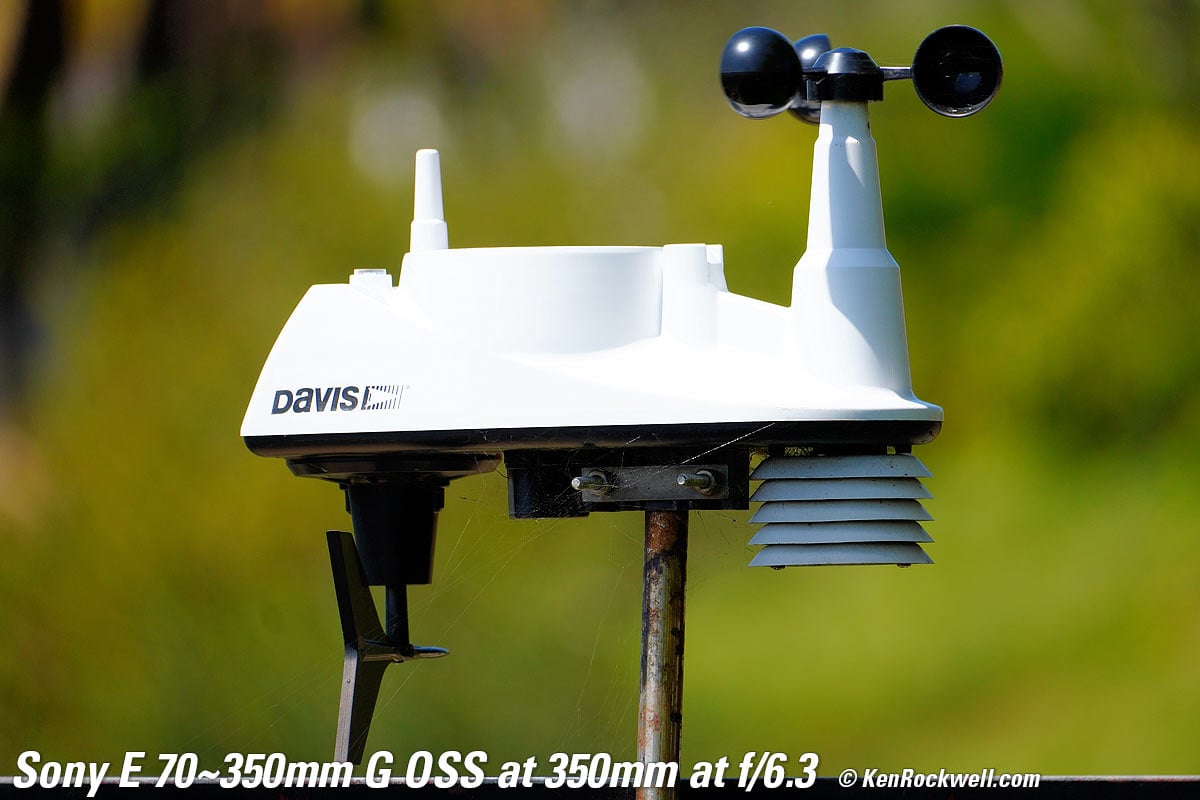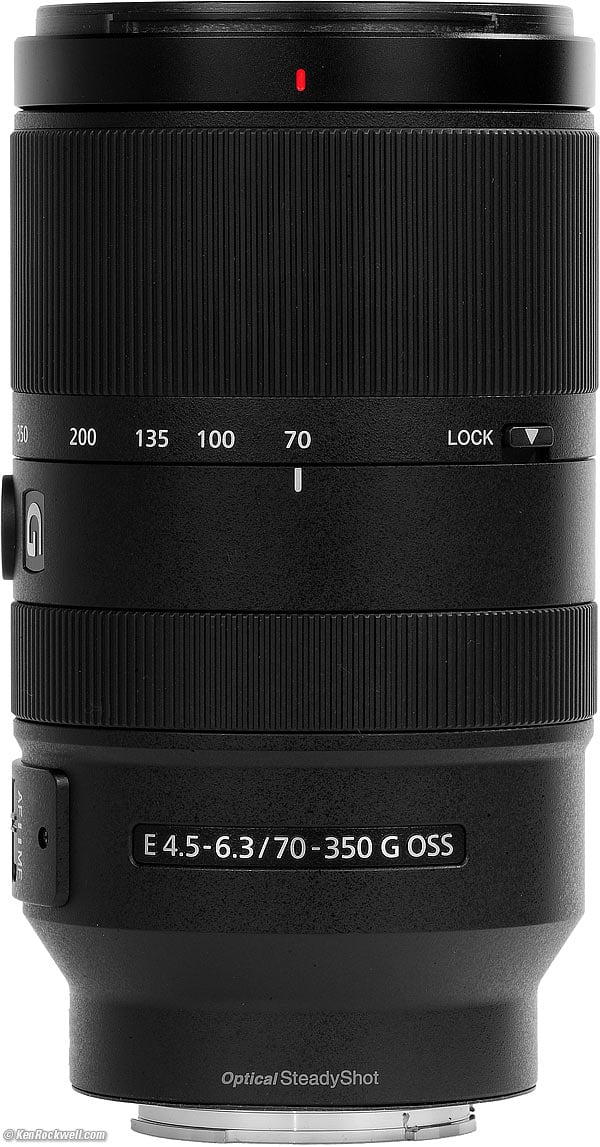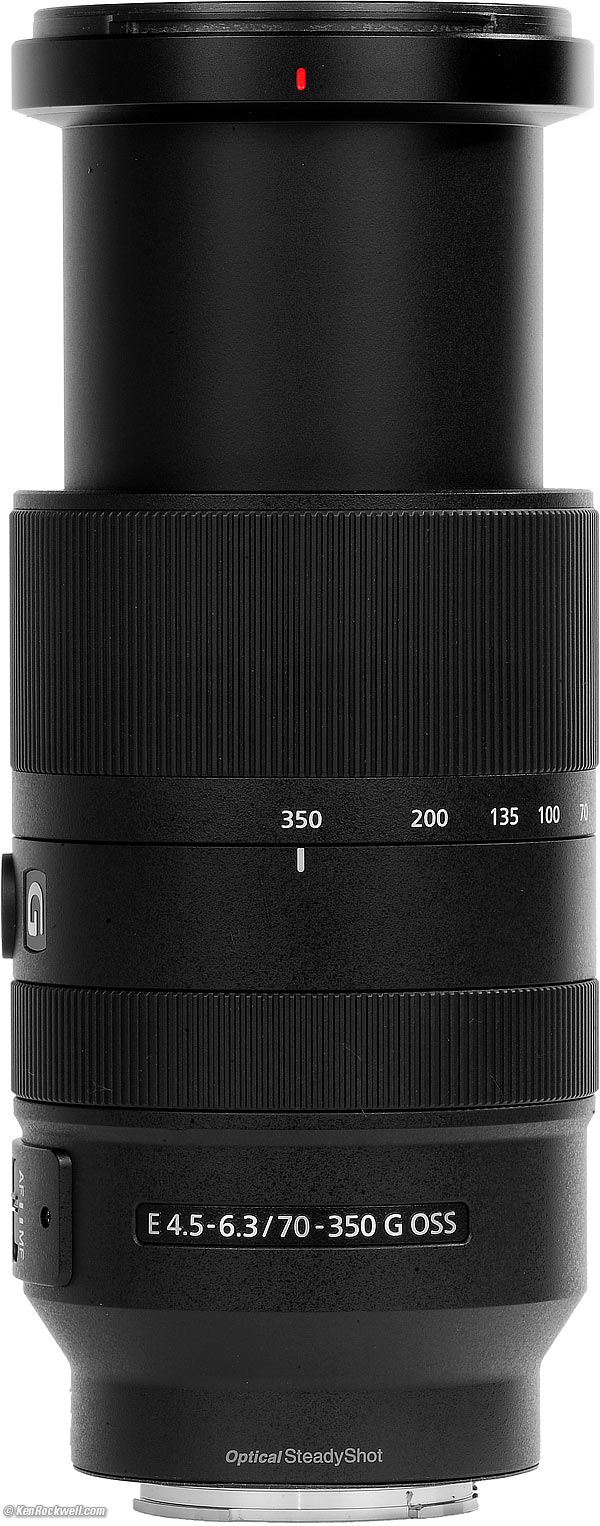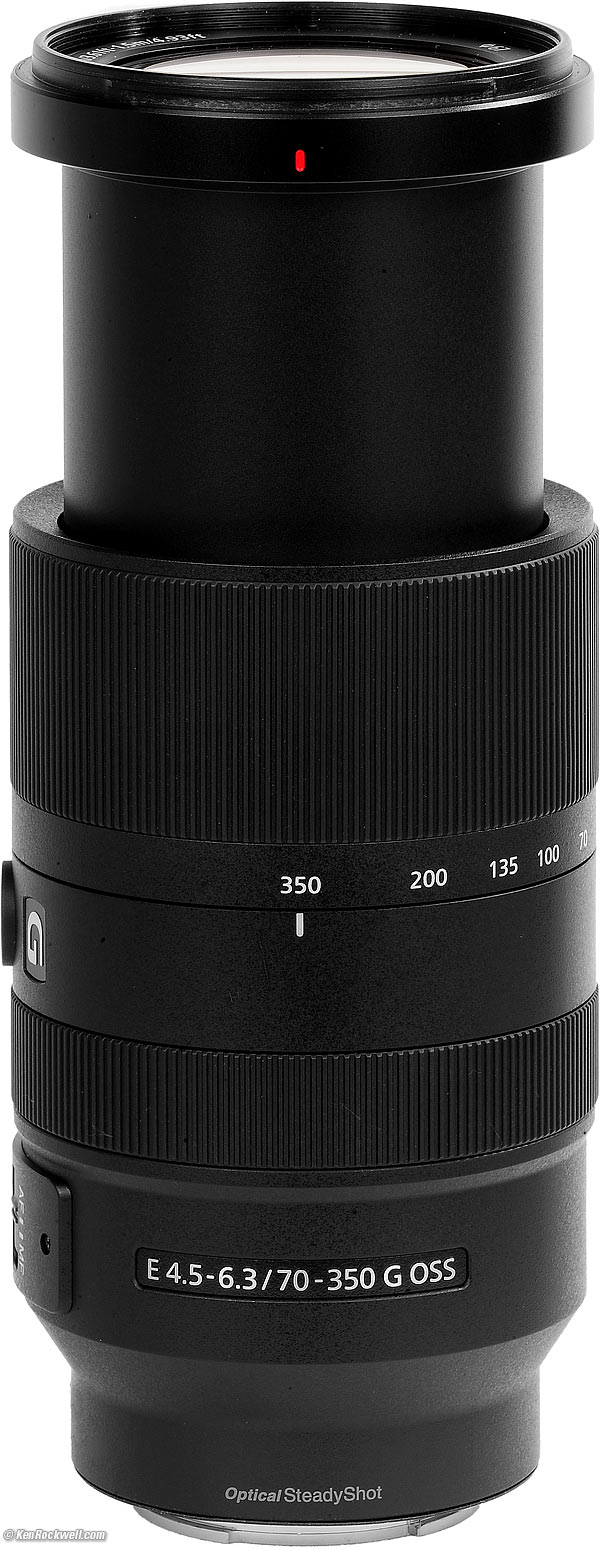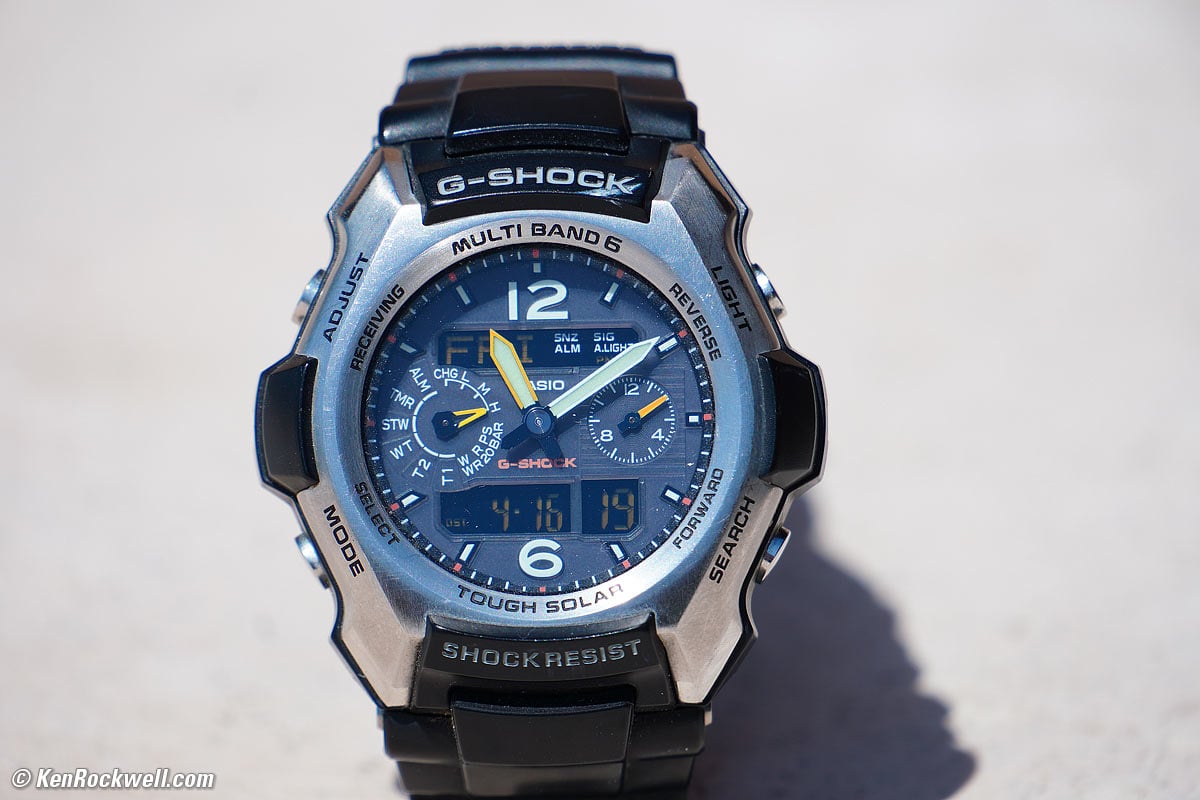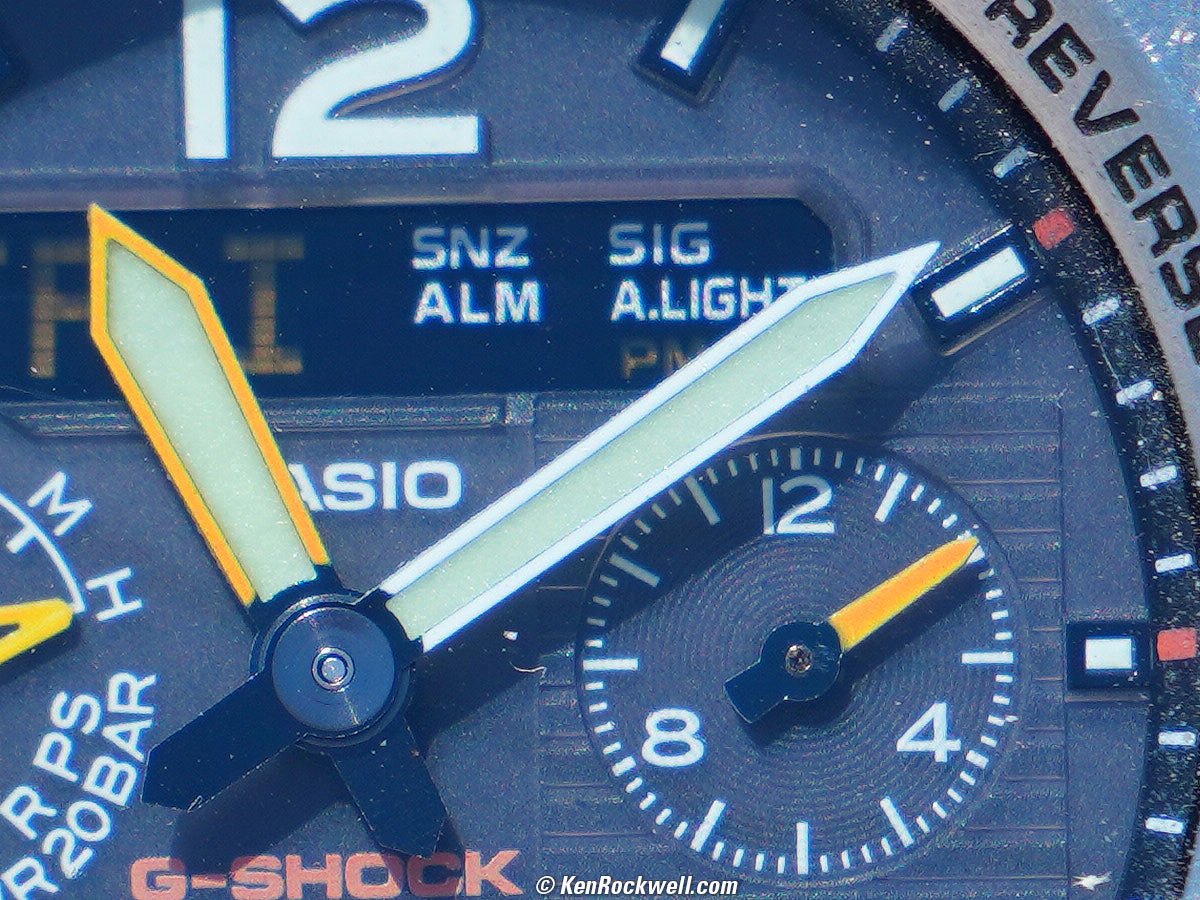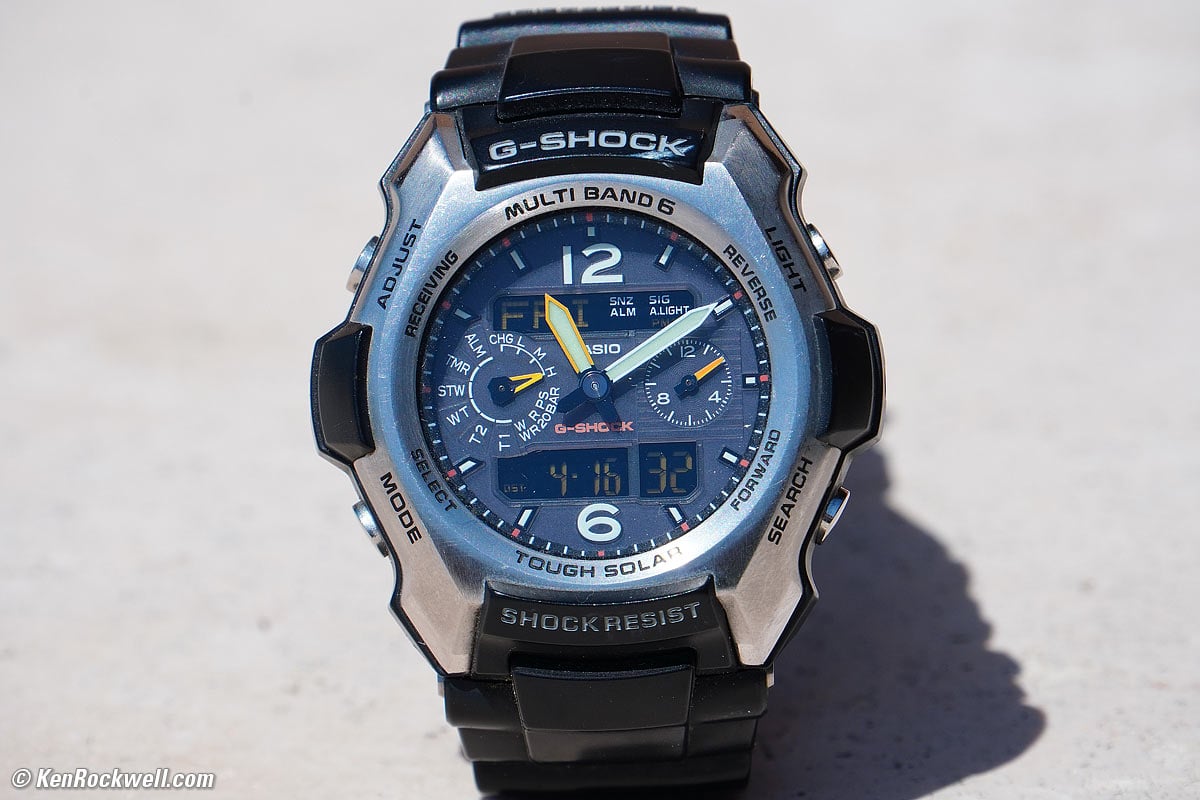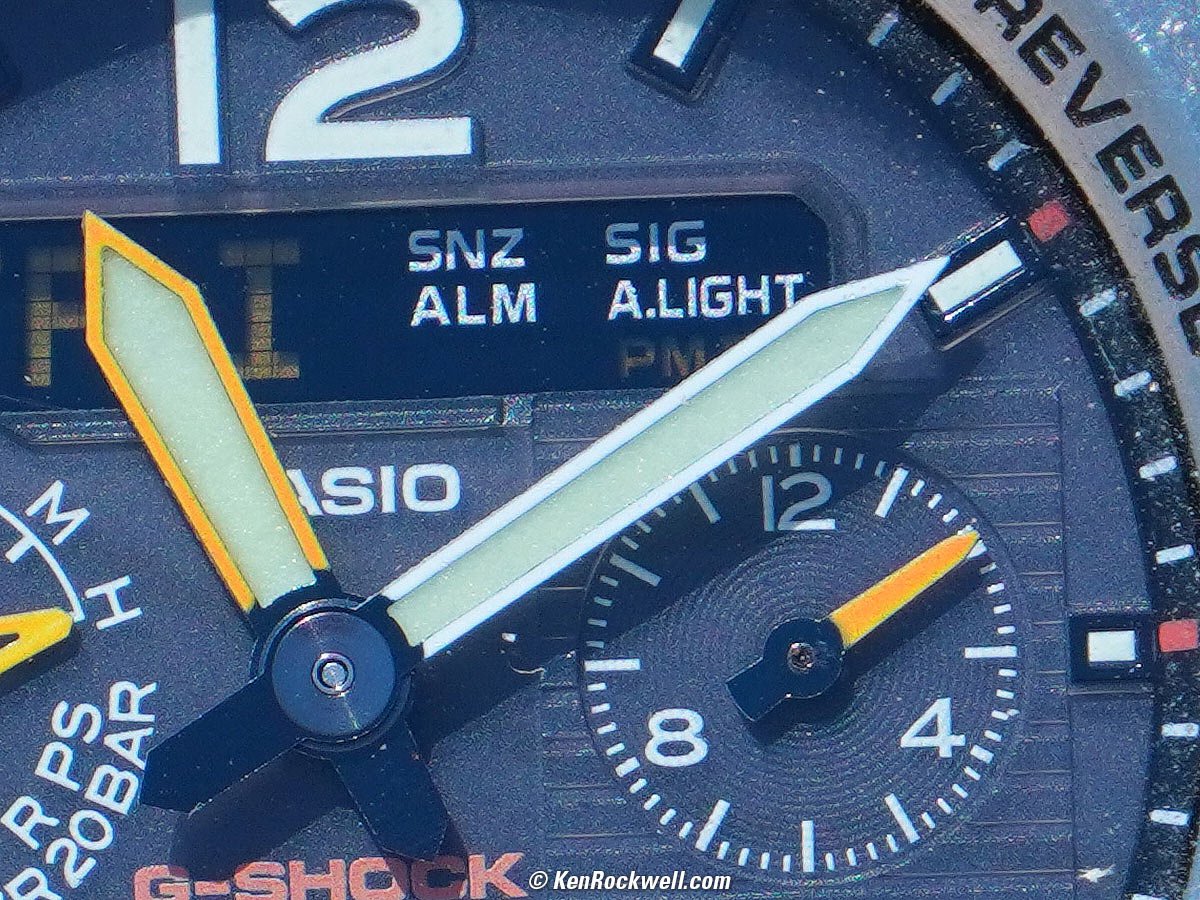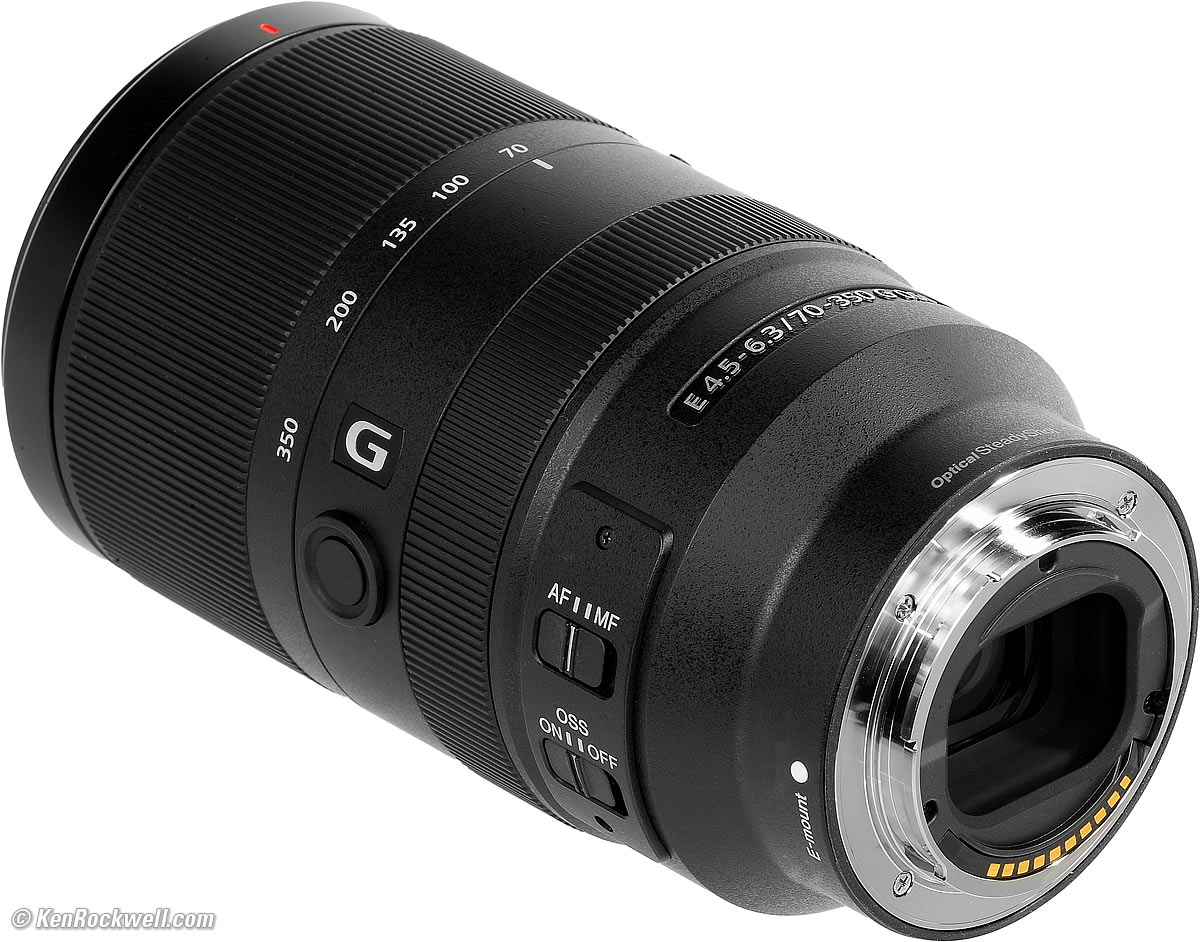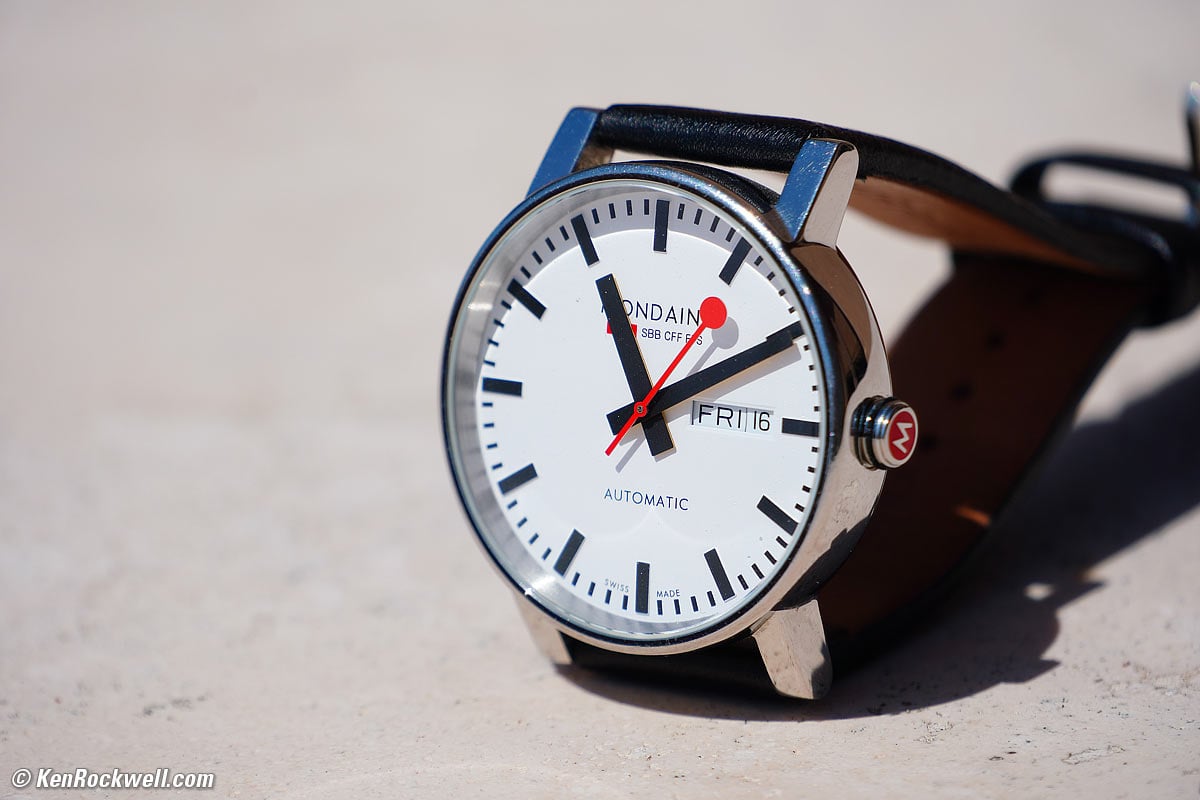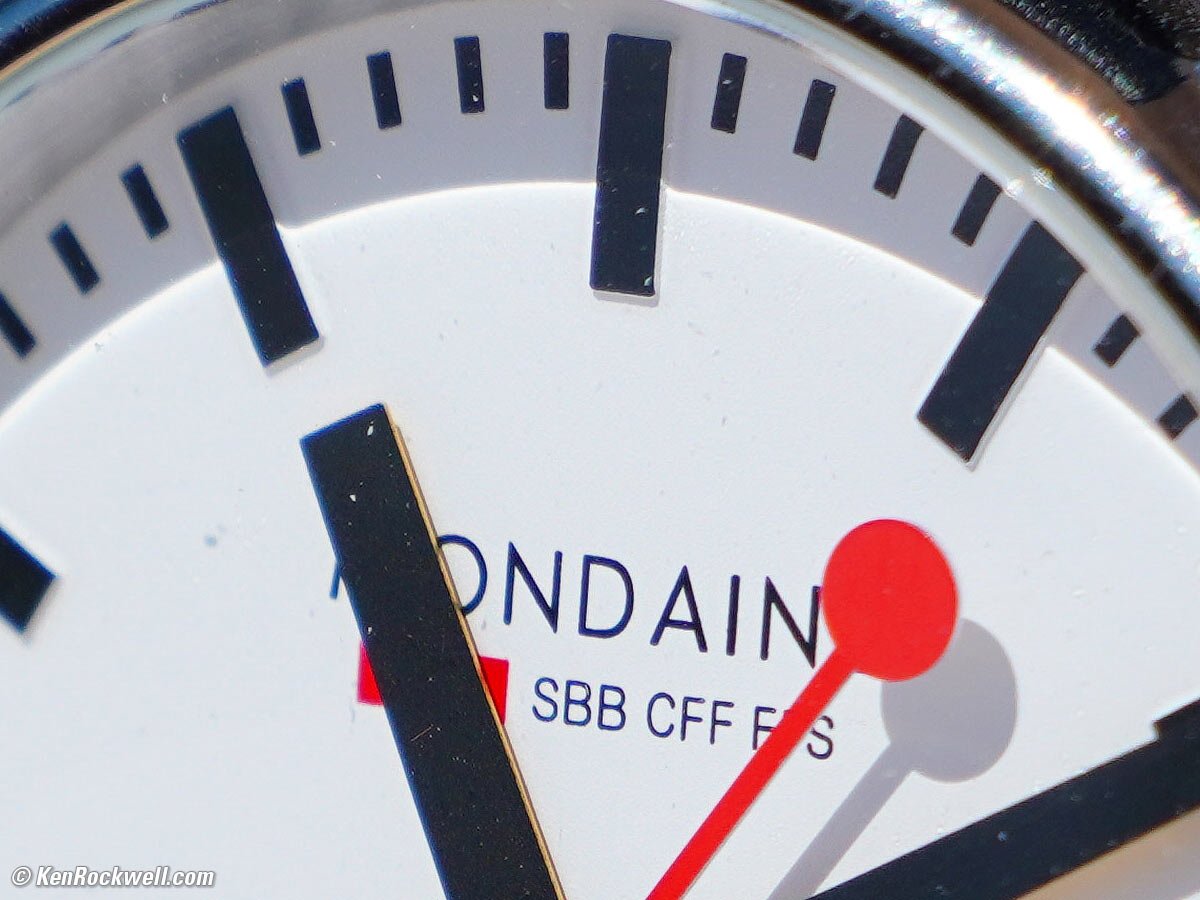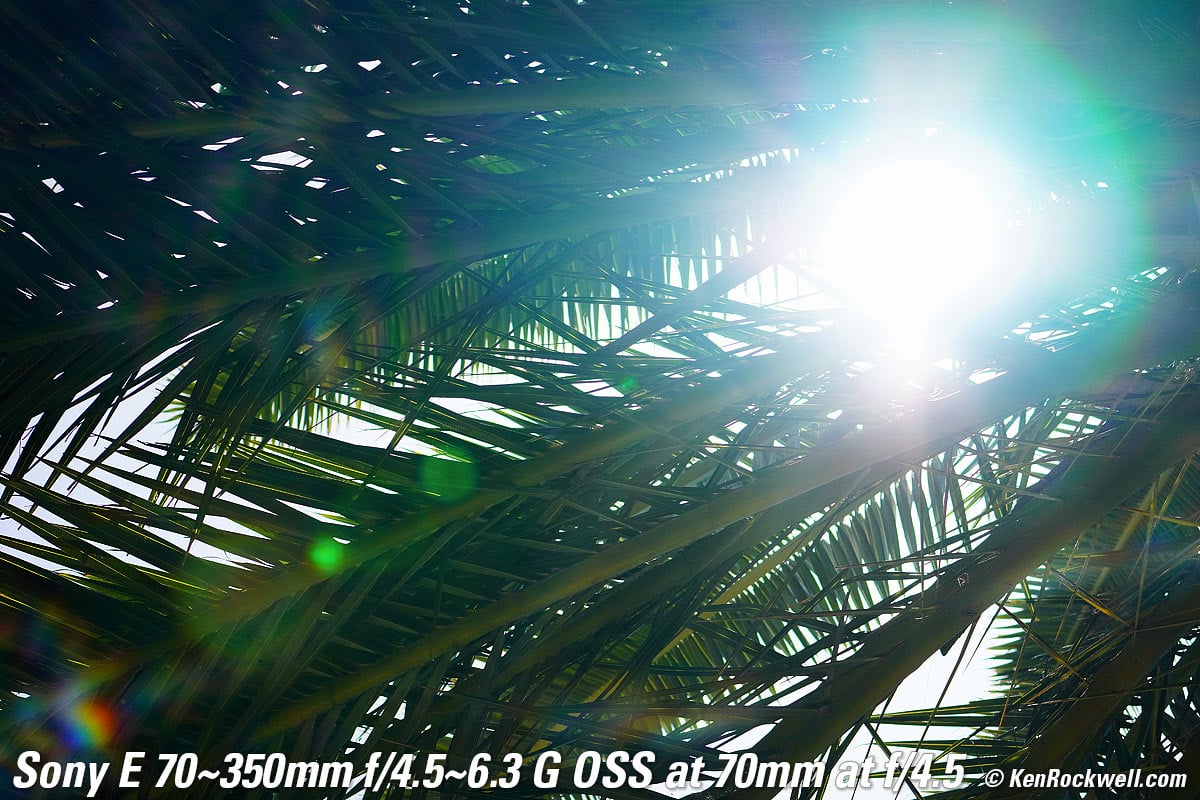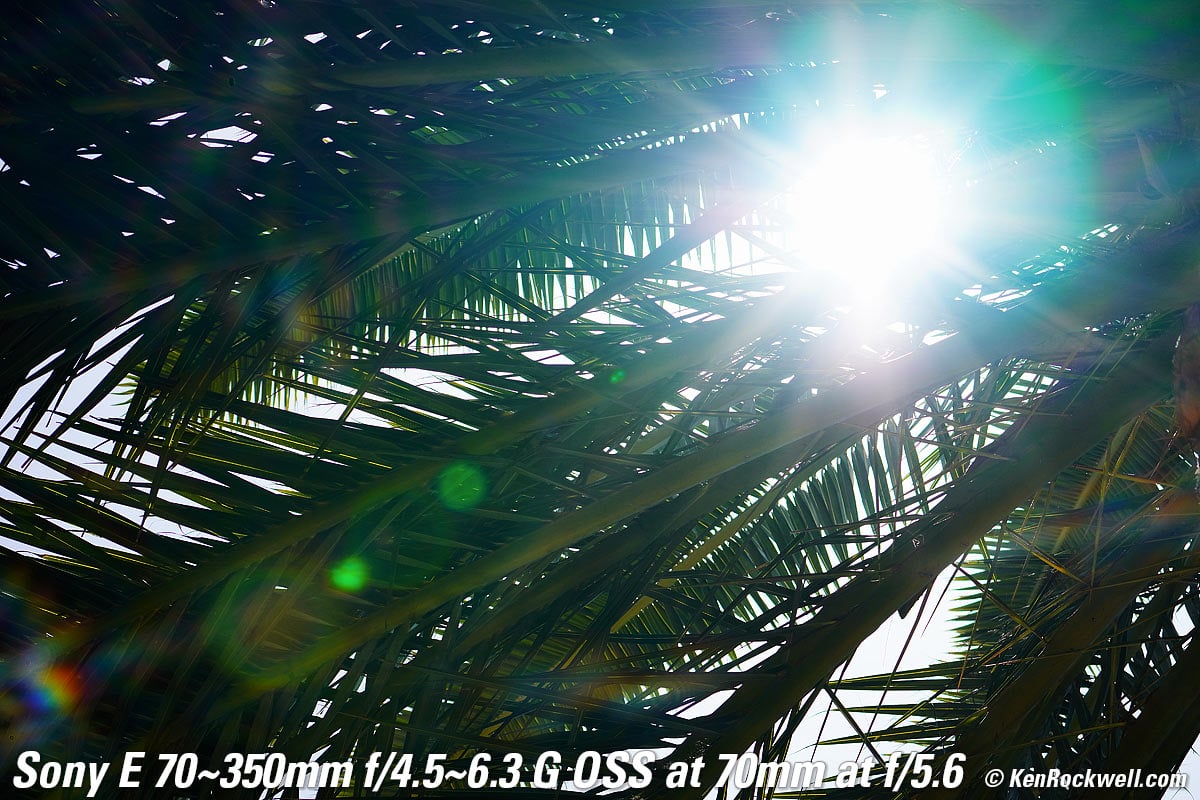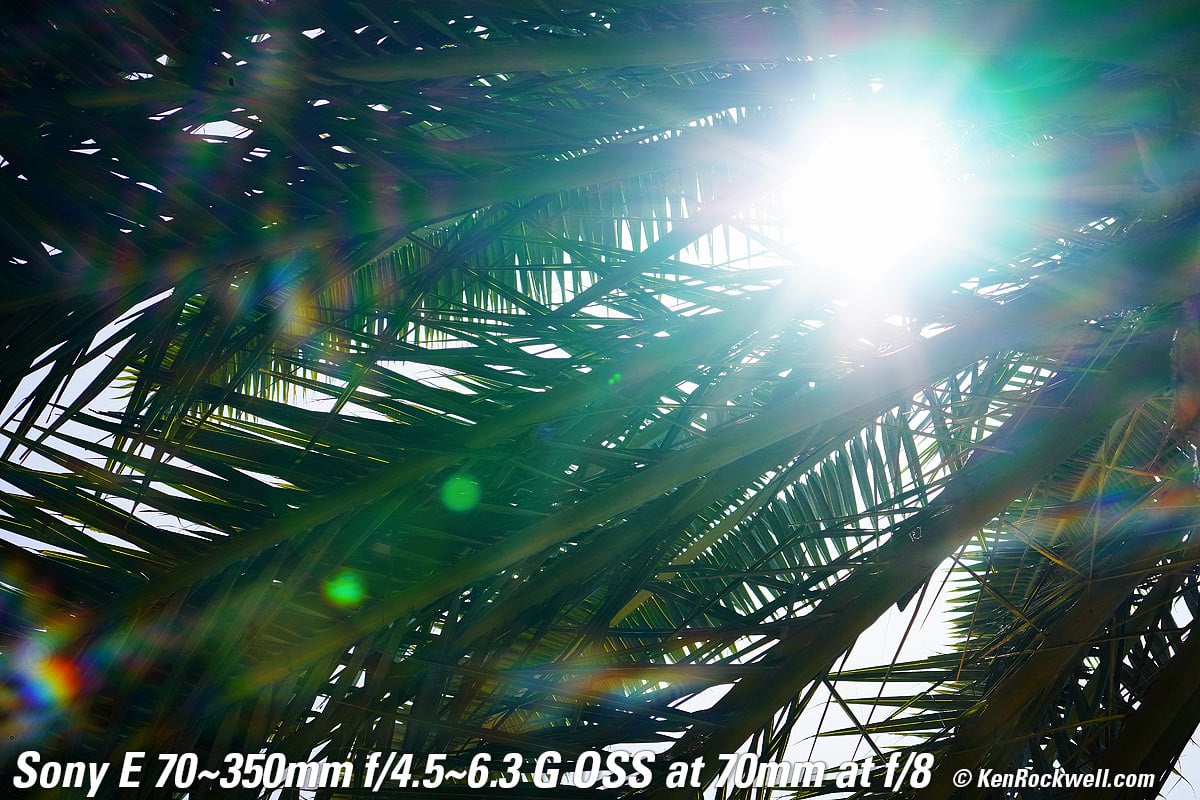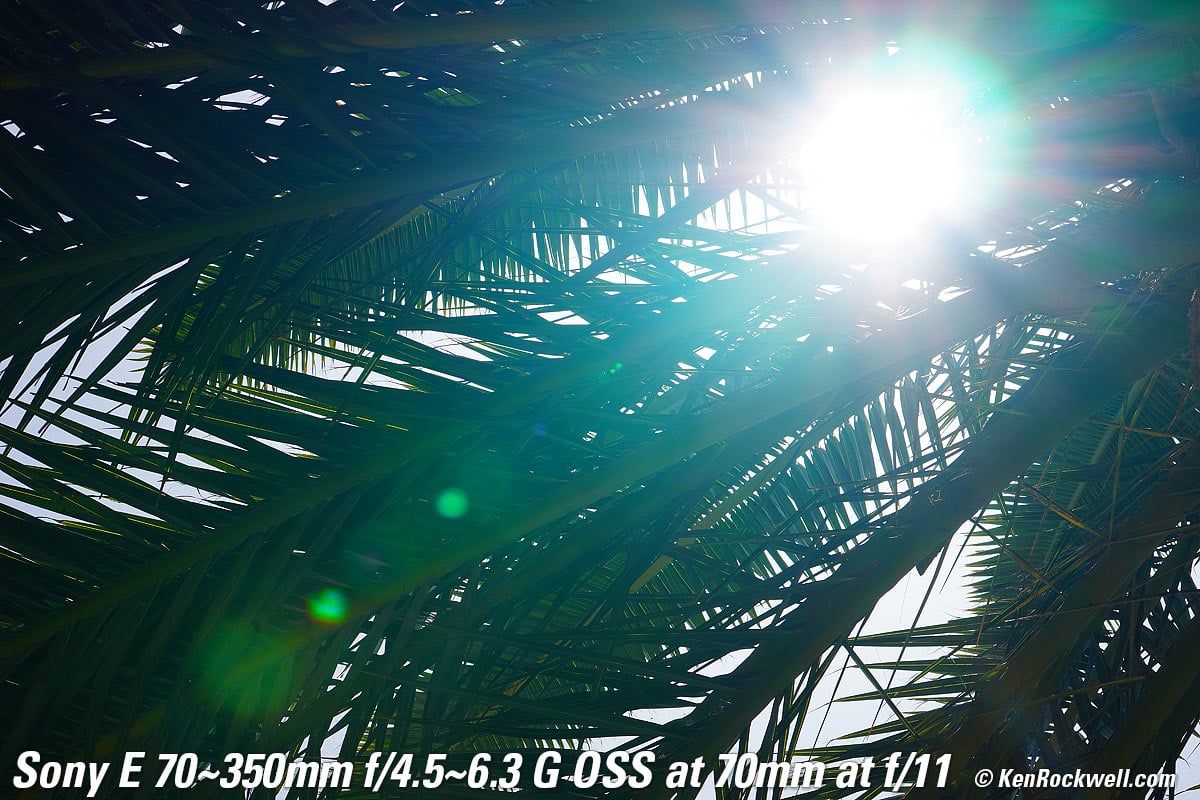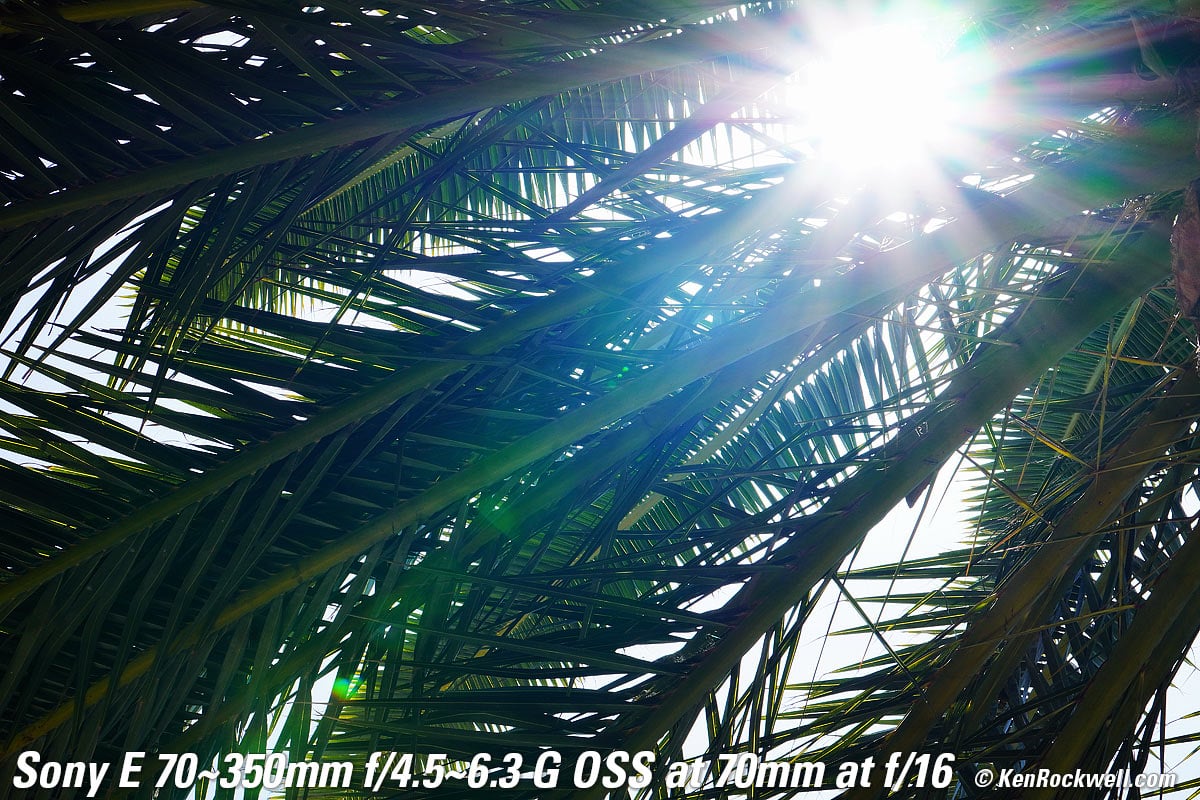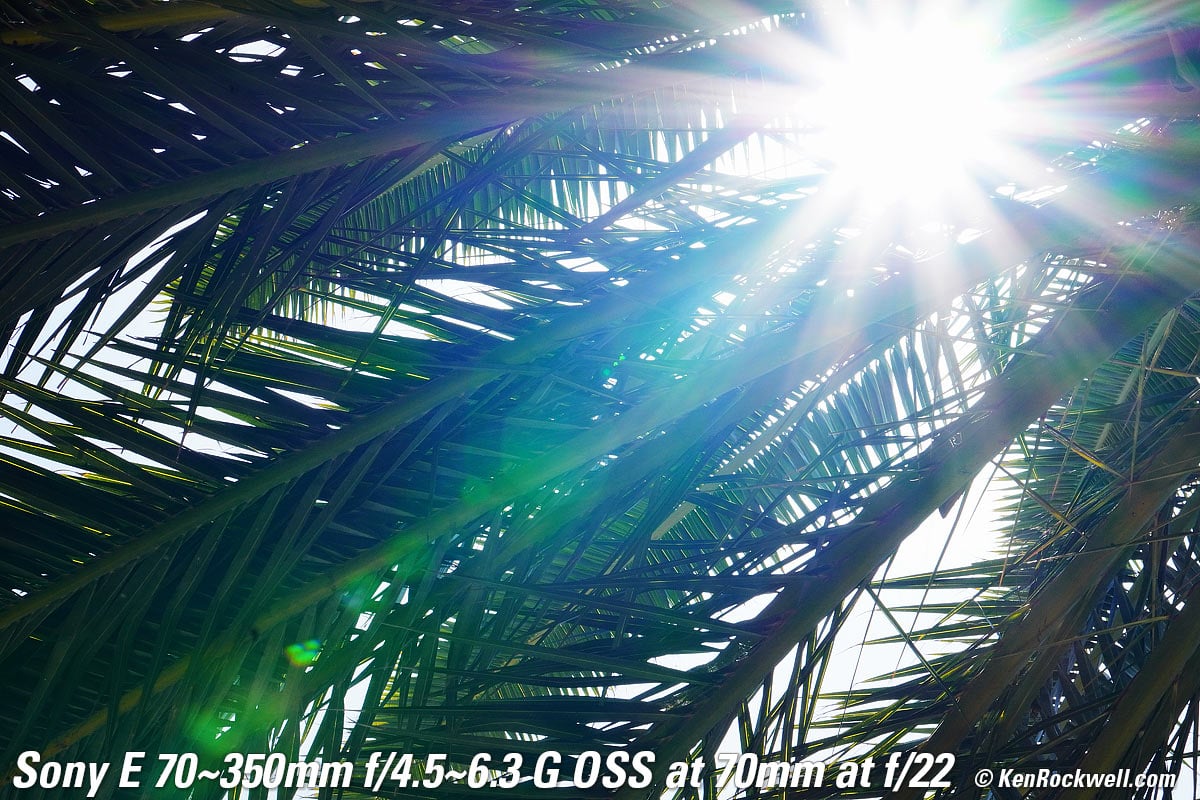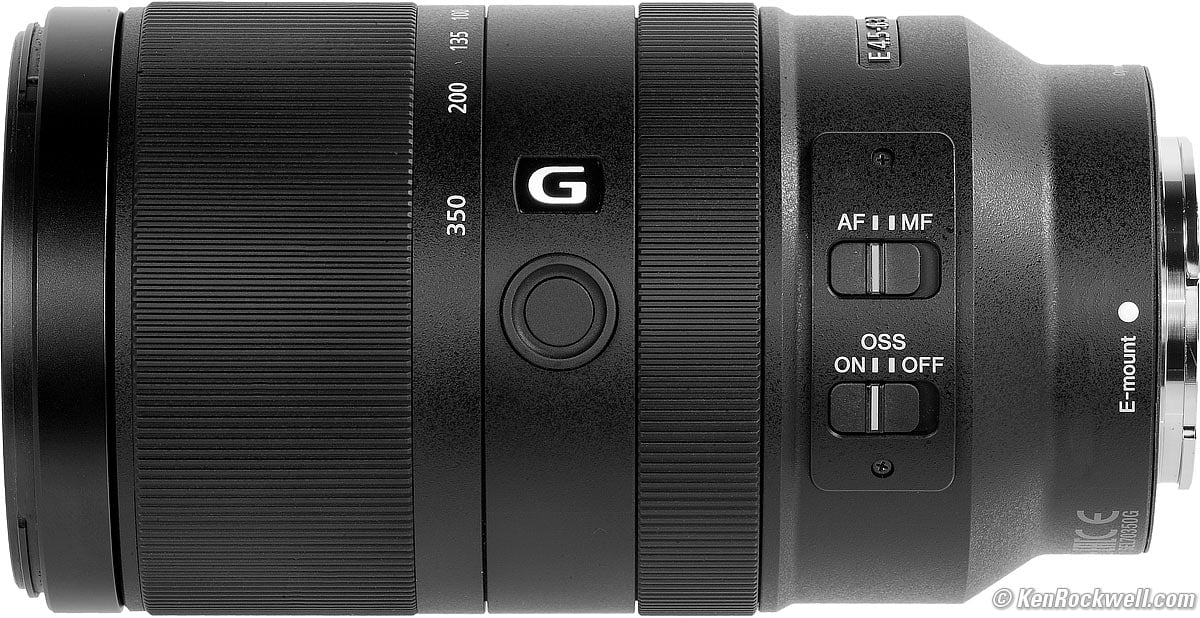Sony E 70-350mm G OSS
Covers APS-C only (2019‑)
Sample Images Introduction Compatibility
Specifications Performance Recommendations
Sony E 70-350mm G OSS (67mm filters, 21.9 oz./621g, 3.6'/1.1m to 4.9'/1.5m close focus, $998). bigger. I'd get mine at Adorama, at Amazon, at B&H or at Crutchfield, or used at eBay if you know How to Win at eBay.
This 100% all-content, junk-free website's biggest source of support is when you use those or any of these links to my personally approved sources I've used myself for way over 100 combined years when you get anything, regardless of the country in which you live. Sony does not seal its boxes in any way, so never buy at retail or any other source not on my personally approved list since you'll have no way of knowing if you're missing accessories, getting a defective, damaged, returned, non-USA, store demo or used lens — and all of my personally approved sources allow for 100% cash-back returns for at least 30 days if you don't love your new lens. I've used many of these sources since the 1970s because I can try it in my own hands and return it if I don't love it, and because they ship from secure remote warehouses where no one gets to touch your new lens before you do. Buy only from the approved sources I've used myself for decades for the best prices, service, return policies and selection.
April 2022 Better Pictures Sony Sony Lenses Zeiss Nikon Canon Fuji LEICA All Reviews
Sony vs. Nikon vs. Canon Full-Frame
Sample Images top
Sample Images Introduction Compatibility
Specifications Performance Recommendations
More samples at Bokeh, Macro, Spherochromatism and Sunstars.
These are just snapshots; my real work is in my Gallery.
These are all shot hand-held as Standard JPGs; no tripods, FINE JPGs or RAW files were used or needed.
Red Plant 10:32 AM, 17 April 2021. Sony A6100, Sony E 70-350mm G OSS at 255mm wide-open at f/6.3 at 1/400 at Auto ISO 400 (LV 12.0), exactly as shot. bigger or camera-original © JPG file.
Sheriff's Helicopter from a mile away, 10:50 AM, 18 April 2021. Cropped from Sony A6100 JPG file, Sony E 70-350mm G OSS at 350mm wide-open at f/6.3 at 1/500 at Auto ISO 100 (LV 14.3), exactly as shot. bigger or camera-original © JPG file.
Is it sharp? You can see the perforations in the vents behind the engine in the original file, and this helicopter is over a mile away!
Crop from above. bigger or camera-original © JPG file.
Not only can you see the perforations, they are so tiny and so well resolved by the lens that they are exciting color aliases in the A6100. Bravo!
Introduction top
Sample Images Introduction Compatibility
Specifications Performance Recommendations
|
I buy only from these approved sources. I can't vouch for ads below. |
This Sony E 70-350mm G OSS is an expensive half-plastic Chinese-made lens with very good optics. It covers a super-long telephoto zoom range (105-525mm equivalent on full-frame) and is often sharper than "seeing" conditions. This means that outdoors this lens is often sharper than the clarity of the air itself over any distance!
If you value zoom range and optics over size, weight and price, this is a great lens. Otherwise the 55-210mm OSS is rightfully very popular for APS-C cameras because it matches the whole point of APS-C: small size and weight.
I'd get my Sony E 70-350mm G OSS at Adorama, at Amazon, at B&H or at Crutchfield, or used at eBay if you know How to Win at eBay.
New intro top
 Sony's first super-tele zoom for APS-C.
Sony's first super-tele zoom for APS-C.
Good intro top
 Super sharp at every setting.
Super sharp at every setting.
 Optical Stabilization.
Optical Stabilization.
 Programmable function button.
Programmable function button.
 Good Sunstars.
Good Sunstars.
 Very good Macro performance.
Very good Macro performance.
 No visible Distortion.
No visible Distortion.
Bad intro top
 Poor image stabilization performance, only gives two stops of real-world improvement, not three of four like most lenses today. This is 1990s-era performance.
Poor image stabilization performance, only gives two stops of real-world improvement, not three of four like most lenses today. This is 1990s-era performance.
 Falloff can be visible if you shoot birds or aircraft against a blank sky.
Falloff can be visible if you shoot birds or aircraft against a blank sky.
 Offshored to China; not made domestically in Japan.
Offshored to China; not made domestically in Japan.
Missing intro top
 Hood included, but no case. So? When's the last time anyone used a single lens case? 1957?
Hood included, but no case. So? When's the last time anyone used a single lens case? 1957?
Sony E 70-350mm G OSS. bigger.
Compatibility top
Sample Images Introduction Compatibility
Specifications Performance Recommendations
I'd get my Sony E 70-350mm G OSS at Adorama, at Amazon, at B&H or at Crutchfield, or used at eBay if you know How to Win at eBay.
This works on all Sony E-mount cameras, full-frame and crop-sensor. This includes all the variations of NEX, A9-, A7-, A6xxx and A5xxx series cameras.
It will not attach to any Sony A-mount DSLR or any Minolta MAXXUM 35mm SLR of any kind. Those use the old A mount which was actually the Minolta MAXXUM mount from 1986.
This is an APS-C lens and ideally should only be used on APS-C cameras, which are the A5xxx and A6xxx series.
While it works fine on full-frame cameras (the A9x and A7x series), since this lens only covers a small APS-C portion of those camera's larger sensors, more than half the sensor pixels are simply thrown away! Use a full-frame lens for the best results on full frame cameras, or use this lens on an APS-C camera for the best results.
Specifications top
Sample Images Introduction Compatibility
Specifications Performance Recommendations
I'd get my Sony E 70-350mm G OSS at Adorama, at Amazon, at B&H or at Crutchfield, or used at eBay if you know How to Win at eBay.
Name specifications top
Sony calls this the E 70-350mm f/4.5-6.3 G OSS:
E: E-mount, APS-C coverage.
G: One of Sony's "Good" lenses.
Sony's model number: SEL70350G.
Optics specifications top
Sony E 70-350mm G OSS internal optical construction. Aspherical and ED elements.
19 elements in 13 groups.
One aspherical element.
Three ED elements.
The front section moves in and out as zoomed.
Autofocus specifications top
No external movement as focussed, so no air or dust is sucked in.
Filters specifications top
Plastic 67mm filter thread.
Diaphragm specifications top
Sony E 70-350mm G OSS (diaphragm not seen). bigger.
7 rounded blades.
Electronically actuated.
Focal Length specifications top
70-350mm.
It sees the same angles of view on an APS-C camera as a 105-525mm lens sees when used on a full-frame or 35mm camera.
See also Crop Factor.
Angles of View on APS-C specifications top
22º ~ 4.7º diagonal.
Focus Scale specifications top
No.
Infinity Focus Stop specifications top
No.
Depth of Field Scale specifications top
No.
Infrared Focus Index specifications top
No.
Close Focus specifications top
3.6 feet (1.1 meters) when set to 70mm.
4.9 feet (1.5 meters) when set to 350mm.
Maximum Reproduction Ratio specifications top
1:4.3 (0.23 ×).
Reproduction Ratio Scale specifications top
No.
Image Stabilizer specifications top
NONE.
Front Cap specifications top
Plastic 67mm cap.
Hood specifications top
ALC-SH160 Hood. bigger.
The ALC-SH160 hood is included.
Case specifications top
None.
Size specifications top
3.03" ø maximum diameter × 5.59" extension from flange.
77 mm ø maximum diameter × 142 mm extension from flange at 16mm. Gets longer set to 350mm.
Weight specifications top
21.900 oz. (621.0g) actual measured weight.
Rated 22.1 oz. (625 g).
Announced specifications top
28 August 2019, 11AM NYC time.
Included specifications top
Lens, hood and caps.
Sony's Model Number specifications top
SEL70350G.
Quality specifications top
Sony E 70-350mm G OSS. bigger.
Offshored to China.
Price, U. S. A. specifications top
April 2022
$998 at Adorama, at Amazon, at B&H or at Crutchfield.
About $700 used if you know How to Win at eBay.
April 2021
$998 at Adorama, at Amazon, at B&H or at Crutchfield.
About $800 used if you know How to Win at eBay.
Performance top
Sample Images Introduction Compatibility
Specifications Performance Recommendations
Overall Autofocus Manual Focus Breathing Bokeh
Distortion Ergonomics Falloff Filters, use with
Flare & Ghosts Lateral Color Fringes
Lens Corrections Macro Maximum & Minimum Apertures
Mechanics Sharpness Spherochromatism
I'd get my Sony E 70-350mm G OSS at Adorama, at Amazon, at B&H or at Crutchfield, or used at eBay if you know How to Win at eBay.
Overall performance top
The 70-350 OSS performs very well. You pay a high price, and it performs as expected.
Autofocus performance top
Autofocus is immediate. Your camera and conditions will be more of a limitation than this lens.
Manual Focus performance top
Manual focusing is entirely electronic; the manual focus ring isn't connected to anything other than a digital encoder.
It works well.
Focus Breathing performance top
Focus breathing is the image changing size as focused in and out. It's important to cinematographers that the image not breathe because it looks funny if the image changes size as focus gets pulled back and forth between actors. If the lens does this, the image "breathes" by growing and contracting slightly as the dialog goes back and forth.
This 70-350mm has almost no breathing. The image from this 70-350 gets only very slightly larger as focussed more closely.
This is excellent performance.
Bokeh performance top
Bokeh, the feel, character or quality of out-of-focus areas as opposed to how far out of focus they are, is only fair to good. While as a long lens backgrounds are usually far out of focus, however the character of this defocus is harsher than optimum.
Here are photos from headshot distance wide-open:
Made-in-U. S. A. Davis 6250 weather station, 16 April 2021. Sony A6100, Sony E 70-350mm G OSS at 70mm at f/4.5 at 1/4,000 at Auto ISO 100 with +0.3 stops exposure compensation (LV 14.9), Perfectly Clear. bigger or camera-original © file.
Made-in-U. S. A. Davis 6250 weather station, 16 April 2021. Sony A6100, Sony E 70-350mm G OSS at 150mm at f/5.6 at 1/4,000 at Auto ISO 100 with +0.3 stops exposure compensation (LV 14.9), Perfectly Clear. bigger or camera-original © file.
Made-in-U. S. A. Davis 6250 weather station, 16 April 2021. Sony A6100, Sony E 70-350mm G OSS at 350mm at f/6.3 at 1/4,000 at Auto ISO 100 with +0.3 stops exposure compensation (LV 14.9), Perfectly Clear. bigger or camera-original © file.
As always, if you want to throw the background as far out of focus as possible, shoot at 350mm at f/6.3 and get as close as possible.
Distortion performance top
The Sony E 70-350mm G OSS has no visible distortion, shot as JPG with distortion correction at its default of ON. At least on my A6100, I can't turn off the automatic correction. It's always ON.
For more critical scientific use, use these corrections in Photoshop's lens correction filter to correct the slight barrel distortion with JPG images. No, I have no idea why my A6100 doesn't correct the distortion completely.
If you shoot raw and use non-manufacturer software to process the raw data into images, that software is unlikely to be able to correct the distortion as is done in-camera as JPGs, so you may be on your own.
These aren't facts or specifications, they are the results of my research that requires hours of photography and calculations on the resulting data.
On APS-C at 30' (10m) |
Correction factor to use with images made with correction ON in A6100 |
70mm |
+0.30 |
100mm |
+0.40 |
135mm |
+0.30 |
200mm |
+0.10 |
350mm |
+0.10 |
© 2021 KenRockwell.com. All rights reserved.
Ergonomics performance top
At 70mm. bigger. |
At 70mm. bigger. |
At 350mm. bigger. |
At 350mm. bigger. |
The front ring is an electronic focus ring.
The rear ring is a traditional mechanical zoom control.
The lens-mounting index is a microscopic white ball which is just about invisible and hard to feel. Poo!
Falloff performance top
Falloff isn't visible in normal photos so long as you leave the default automatic correction ON.
However if you're shooting birds or aircraft or anything else against a plain sky, you probably will be able to see darker corners, which will highlight your subject — or require some other processing to lighten the corners a bit. See the helicopter photo above, for instance.
I've greatly exaggerated the falloff by shooting a gray field and placing these on a gray background; it will not look even this bad in actual photos of real things unless your photo has a blank sky filling the frame:
Sony 70-350mm falloff on A6100 (APS-C) at infinity, correction at default of ON:
© 2021 KenRockwell.com. All rights reserved. |
If you go out of your way to turn off falloff correction and then go looking for it, you can see some at the long and short ends wide-open:
Sony 70-350mm falloff on A6100 (APS-C) at infinity, correction turned OFF:
© 2021 KenRockwell.com. All rights reserved. |
Filters, use with performance top
There's no need for thin 67mm filters, you can stack a couple of regular 67mm filters with no vignetting.
Flare & Ghosts performance top
Flare and ghosts are well controlled.
See examples at Sunstars.
Lateral Color Fringes performance top
Shot as JPG with the default Chromatic Aberration Correction left ON in my A6100 there is just a tiny bit of blue/red fringing at all focal lengths.
if you go out of your way to turn this correction OFF (or shoot raw and then use non-manufacturer software to process that data into images) then there is just the tiniest bit of blue/red fringing at 70 mm, some magenta-red/green-yellow fringing at 150mm and a moderate amount of magenta-red/green-yellow fringing at 350mm.
Lens Corrections performance top
My Sony A6100 corrects for any or all of Falloff ("Shading Comp."), Lateral Color ("Chromatic Aberratio…") and Distortion (Distortion Comp.).
By default, they are all ON ("Auto").
On my Sony A6100, I can turn the Falloff ("Shading") and Lateral Color ("Chromatic Aberratio…") corrections ON (Auto) or OFF, but the Distortion (Distortion Comp.) correction is always ON (Auto). In other words, My A6100 won't let me turn off distortion correction.
These corrections apply to images shot as JPG, as I always shoot. If you shoot raw data, the software you use to turn the raw data into an image may or may not apply any of these corrections in the process. Sony's software might, but non-Sony software probably won't. I never shoot raw.
Macro Performance performance top
Macro gets closer than most lenses, and it's pretty sharp. Great!
At f/6.3
Casio G-Shock Solar Atomic Watch at close-focus distance at 350mm, 16 April 2021. bigger or camera-original © file.
It has some residual spherical aberration that makes it a bit less sharp wide-open here at f/6.3:
1,200 × 900 pixel (5×) crop from above. bigger or camera-original © file.
If this 1,200 × 900 pixel crop is about 3" (7.5cm) wide on your screen, then the complete image printed at this same large magnification would be about 10 × 15" (25 × 38cm).
If this 1,200 × 900 pixel crop is about 6" (15cm) wide on your screen, then the complete image printed at this same extreme magnification would be about 20 × 30" (50 × 75cm).
If this 1,200 × 900 pixel crop is about 12" (30cm) wide on your screen, then the complete image printed at this same insanely high magnification would be about 40 × 60" (1 × 1.5 meters).
At f/11
It's super sharp at f/11:
Casio G-Shock Solar Atomic Watch at close-focus distance at 350mm, 16 April 2021. bigger or camera-original © file.
1,200 × 900 pixel (5×) crop from above. bigger or camera-original © file.
If this 1,200 × 900 pixel crop is about 3" (7.5cm) wide on your screen, then the complete image printed at this same large magnification would be about 10 × 15" (25 × 38cm).
If this 1,200 × 900 pixel crop is about 6" (15cm) wide on your screen, then the complete image printed at this same extreme magnification would be about 20 × 30" (50 × 75cm).
If this 1,200 × 900 pixel crop is about 12" (30cm) wide on your screen, then the complete image printed at this same insanely high magnification would be about 40 × 60" (1 × 1.5 meters).
Maximum & Minimum Apertures performance top
Maximum Aperture |
Minimum Aperture |
|
| 70mm | f/4.5 |
f/22 |
| 100mm | f/5 |
f/25 |
| 135mm | f/5.6 |
f/25 |
| 200mm | f/6.3 |
f/29 |
| 350mm | f/6.3 |
f/32 |
Mechanical Quality performance top
Sony E 70-350mm G OSS. bigger.
This lens has great optics, but mechanically it's a mostly plastic lens offshored to China. It's an ephemeral item made to create immortal images and then be thrown away, not passed down from generation to generation as an heirloom itself.
Front Bumper
None.
Filter Threads
Plastic.
Hood Bayonet Mount
Plastic.
Front Trim Ring (section with red index dot)
Metal.
Front Barrel
Plastic.
Zoom Ring
Rubber-covered plastic.
Mid Barrel
Plastic.
Big Button
Plastic.
Focus Ring
Rubber-covered plastic.
Rear Barrel
Plastic.
Slide Switches
Plastic.
Identity
Printed around front lens element.
Metallic plate on top of barrel.
Internals
Seems like all plastic, except for the glass elements.
Dust Gasket at Mount
Yes.
Mount
Chromed brass.
Markings
Painted.
Serial Number
Serial Number, Sony E 70-350mm G OSS. bigger.
Printed on a sticker glued to the bottom of the barrel. Why bother?
This isn't acceptable for a serious lens. The problem is that the serial number should wear off from usage, and good luck getting service or selling this eventually without a serial number. Good luck!
Date Code
None found.
Noises When Shaken
Moderately loud clunking from the uncaged focussing group flopping around inside the lens. These don't cage or lock-down when the power is off.
Made in
Offshored to China.
Sharpness performance top
Lens sharpness has nothing to do with picture sharpness; every lens made in the past 100 years is more than sharp enough to make super-sharp pictures if you know what you're doing. The only limitation to picture sharpness is your skill as a photographer. It's the least talented who spend the most time worrying about lens sharpness and blame crummy pictures on their equipment rather than themselves. Skilled photographers make great images with whatever camera is in their hands; I've made some of my best images of all time with an irreparably broken camera! Most pixels are thrown away before you see them, but camera makers don't want you to know that.
If you're not getting ultra-sharp pictures with this, be sure not to shoot at f/16 or smaller where all lenses are softer due to diffraction, always shoot at ISO 100 or below because cameras become softer at ISO 200 and above, be sure everything is in perfect focus, set your camera's sharpening as you want it and be sure nothing is moving, either camera or subject. If you want to ensure a soft image with any lens, shoot at f/22 at ISO 1,600 in daylight of moving subjects at differing distances in the same image.
This lens is super-sharp used properly from corner-to corner. Bravo!
Beware, however that at 350mm it's so sharp that it will show any heat shimmer quite clearly if you're shooting anything more than about 30'/10 meters away. Heat shimmer is caused by different temperatures from here to there that change the index of refraction of the air through which we're looking; it's related to mirages. For instance I can see that the high-voltage towers a mile away use clear glass insulators through this lens, even though the heat shimmer makes so many waves that the power lines themselves are quite wiggly..
Here are Sony's MTF charts at 10 cyc/mm and 30 cyc/mm, radial (solid) and tangential (dotted). I don't believe them; they look like calculated (not measured) curves and appear to be ignoring diffraction:
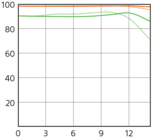 |
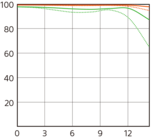 |
MTF at 70mm at f/4.5. |
MTF at 70mm at f/8. |
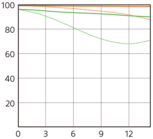 |
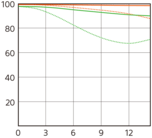 |
MTF at 350mm at f/6.3. |
MTF at 350mm at f/8. |
Spherochromatism performance top
Spherochromatism, also called secondary spherical chromatic aberration or "color bokeh," is an advanced form of spherical and chromatic aberration in a different dimension than lateral chromatic aberration. It happens mostly in fast normal and tele lenses when spherical aberration at the ends of the color spectrum are corrected differently than in the middle of the spectrum. Spherochromatism can cause colored fringes on out-of-focus highlights, usually seen as green fringes on backgrounds and magenta fringes on foregrounds. Spherochromatism is common in fast lenses of moderate focal length when shooting contrasty items at full aperture. It goes away as stopped down.
Spherochromatism is very well controlled, which makes sense as it's a slow lens:
Mondaine A132.30348.11SBB at close-focus distance at 55mm at f/2.8, 15 April 2021. bigger or camera-original © file.
1,200 × 900 pixel (5×) crop from above. bigger or camera-original © file.
If this 1,200 × 900 pixel crop is about 3" (7.5cm) wide on your screen, then the complete image printed at this same large magnification would be about 10 × 15" (25 × 38cm).
If this 1,200 × 900 pixel crop is about 6" (15cm) wide on your screen, then the complete image printed at this same high magnification would be about 20 × 30" (50 × 75cm).
If this 1,200 × 900 pixel crop is about 12" (30cm) wide on your screen, then the complete image printed at this same extreme magnification would be about 40 × 60" (1 × 1.5 meters).
Image Stabilization performance top
Optical Image Stabilization (OIS, Optical Steady Shot (OSS) or VR (Vibration Reduction)) barely works. It gives only a two-stop real-world improvement, which was typical performance for the dawn of image stabilization back in the 1990s in Canon's EF 28-135mm IS and Nikon's first AF-D 80-400mm VR.
"Percent Perfectly Sharp Shots" are the percentage of frames with 100% perfect tripod-equivalent sharpness I get when I'm shooting hand-held while free-standing with no support or bracing. Hand tremor is a random occurrence, so at marginal speeds some frames will be perfectly sharp while others will be in various stages of blur — all at the same shutter speed. This rates what percentage of shots are perfectly sharp, not how sharp are all the frames:
This is as shot on an unstabilized A6100. Most lenses today have around three or four stops on an unstabilized camera, so especially for a long telephoto this is poor performance.
At 70mm on an unstabilized A6100
| % Perfectly Sharp Shots | 1/2 |
1/4 |
1/8 |
1/15 |
1/30 |
1/60 |
1/125 |
1/250 |
| OSS ON | 0 |
16 |
17 |
100 |
100 |
100 |
100 |
100 |
| OSS OFF | 0 |
0 |
0 |
0 |
17 |
50 |
100 |
100 |
I see a 2½ stop real-world improvement. It's not much, but better than nothing.
At 150mm on an unstabilized A6100
| % Perfectly Sharp Shots | 1/2 |
1/4 |
1/8 |
1/15 |
1/30 |
1/60 |
1/125 |
1/250 |
| OSS ON | 1 |
17 |
5 |
14 |
17 |
100 |
100 |
100 |
| OSS OFF | 0 |
0 |
0 |
0 |
15 |
17 |
33 |
100 |
I see only a 2 stop real-world improvement, which is pathetic. 2-stop real-world improvements were awesome in the 1990s, but sloppy today.
At 350mm on an unstabilized A6100
| % Perfectly Sharp Shots | 1/4 |
1/8 |
1/15 |
1/30 |
1/60 |
1/125 |
1/250 |
1/500 |
| OSS ON | 0 |
10 |
18 |
17 |
67 |
100 |
100 |
100 |
| OSS OFF | 0 |
0 |
0 |
7 |
17 |
33 |
67 |
100 |
I see only a 2 stop real-world improvement, which is pathetic. 2-stop real-world improvements were awesome in the 1990s, but sloppy today.
Sunstars performance top
I get great 18-pointed sunstars on brilliant points of light, but only at smaller apertures because of the rounded blades.
Likewise ignore the crazy rainbow effects at small apertures; these are sensor artifacts caused by taking a picture directly of the sun and exposing for the dark underside of a huge palm tree, and using that same palm tree to hide the sky to accentuate the stars.
Click any to enlarge:
Click any to enlarge.
User's Guide top
Sample Images Intro Format Compatibility Specifications Accessories
Sample Images Introduction New Good Bad Missing Format Compatibility Specifications Accessories
Unboxing USA Version Performance Compared User's Guide Recommendations More
I'd get my Sony E 70-350mm G OSS at Adorama, at Amazon, at B&H or at Crutchfield, or used at eBay if you know How to Win at eBay.
Sony E 70-350mm G OSS. bigger.
AF - MF Switch user's guide top
AF: Auto Focus. You have instant manual focus override by turning the focus ring at any time. It will try to ignore minor accidental bumps.
MF: Manual Focus only.
Manual-Focus Override user's guide top
By default, there is no always-responsive instant manual-focus override as we take for granted in our DSLRs.
It all depends on how you set your Sony camera and only works in some modes. Good luck!
Vibration Reduction (OSS) Switch user's guide top
Leave it ON unless you're on a very sturdy tripod, or if you're making exposures longer than a second on any kind of tripod.
Tripod Collar user's guide top
There is no tripod collar. Thank goodness this lens isn't big enough for that.
Recommendations top
Sample Images Introduction Compatibility
Specifications Performance Recommendations
I'd get my Sony E 70-350mm G OSS at Adorama, at Amazon, at B&H or at Crutchfield, or used at eBay if you know How to Win at eBay.
This is a great lens optically and especially if you need 350mm (who doesn't?), but I'd also consider the tiny and inexpensive 55-210mm OSS, since size and weight is the whole point of APS-C cameras.
Thank goodness Sony gives all of us all these different lens choices so we all can be happy. This is a great lens, but why not save $700 for when you go full-frame and just get the 55-210mm OSS and save all the weight?
I use a clear (UV) protective filter instead of a cap so I'm always ready to shoot instantly. I only use a cap when I throw this in a bag with other gear without padding — which is never. The UV filter never gets in the way, and never gets lost, either.
The very best protective filter is the Hoya multicoated HD3 67mm UV which uses hardened glass and repels dirt and fingerprints.
For less money, the B+W 67mm 010 is an excellent filter, as are the multicoated version and the basic multicoated Hoya filters, but the Hoya HD3 is the toughest and the best.
If I was working in nasty, dirty areas, I'd forget the cap, and use an uncoated 67mm Tiffen UV filter instead. Uncoated filters are much easier to clean, but more prone to ghosting.
Filters last a lifetime, so you may as well get the best. The Hoya HD3 stays cleaner than the others since it repels oil and dirt.
All these filters are just as sharp and take the same pictures, the difference is how much abuse they'll take and stay clean and stay in one piece. Since filters last a lifetime or more, there's no reason not to buy the best as it will last you for the next 40 years. Filters aren't throwaways like digital cameras which we replace every few years, like it or not. I'm still using filters I bought back in the 1970s!
This 100% all-content website's biggest source of support is when you use those or any of these links to approved sources when you get anything, regardless of the country in which you live. Sony does not seal its boxes in any way, so especially with an exotic lens like this never buy at retail or any other source not on my personally approved list since you'll have no way of knowing if you're missing accessories, getting a defective, damaged, returned, non-USA, store demo or used lens. I use the stores I do because they ship from secure remote warehouses where no one gets to touch your new camera before you do. Buy only from the approved sources I use myself for the best prices, service, return policies and selection.
Thanks for helping me help you!
Ken Rockwell.
© Ken Rockwell. All rights reserved. Tous droits réservés. Alle Rechte vorbehalten.
Help Me Help You
I support my growing family through this website, as crazy as it might seem.
The biggest help is when you use any of these links when you get anything. It costs you nothing, and is this site's, and thus my family's, biggest source of support. These places always have the best prices and service, which is why I've used them since before this website existed. I recommend them all personally.
If you find this page as helpful as a book you might have had to buy or a workshop you may have had to take, feel free to help me continue helping everyone.
If you've gotten your gear through one of my links or helped otherwise, you're family. It's great people like you who allow me to keep adding to this site full-time. Thanks!
If you haven't helped yet, please do, and consider helping me with a gift of $5.00.
As this page is copyrighted and formally registered, it is unlawful to make copies, especially in the form of printouts for personal use. If you wish to make a printout for personal use, you are granted one-time permission only if you PayPal me $5.00 per printout or part thereof. Thank you!
Thanks for reading!
Ken Rockwell.
